The Watchers (PG-13)

Starring: Dakota Fanning
June 2024
Warning! This is NOT a movie review. This is a critique of the film. Intended to initiate a dialogue, the following analysis explores various aspects of the film and may contain spoilers. For concerns over objectionable content, please first refer to one of the many parental movie guide websites. Ratings are based on a four star system. Happy reading!
Mina (Dakota Fanning) is a bored pet store employee who prefers vaping and doodling in her sketchbook to doing actual work. Her boss asks her to deliver a golden parakeet to a nearby town in Ireland. She reluctantly agrees, probably figuring a drive through the country would be preferable to staring at lizards and snakes all day. Most people would question their GPS when finding themselves on a single-track dirt road in the middle of a dense forest, but not Mina.
When her car dies, Mina strolls into the forest to find help, but immediately gets lost. As night approaches, she encounters Madeline (Olwen Fouéré), an old woman who tells her to get inside a concrete bunker before vicious creatures (Watchers) come out to hunt. Once safely inside the large rectangular room, Mina meets the other survivors, Ciara (Georgina Campbell) and Daniel (Oliver Finnegan). They mindlessly recite the rules as if in a trance: don’t open the door after dark, don’t turn your back on the mirror, don’t go near the burrows (giant holes in the ground), etc.
During the day, the four survivors go outside to hunt for small game, collect medicinal herbs and venture out as far as they dare in every direction to make a map of the region…but they must always return by sundown. One night, there’s a banging at the door. It’s Ciara’s husband John (Alistair Brammer), who’s been missing for several days. His urgent cries for help are soon drowned out by the shrieking howls of the rapidly approaching Watchers.
Should they risk letting him in?
This is just one of several really good suspense scenes in the lost-in-the-woods thriller The Watchers, which marks the directorial debut of Ishana Shyamalan, daughter of M. Night Shyamalan (The Sixth Sense). Ishana also wrote the script, which is based on the book of the same name by A.M. Shine.
The movie starts out well with an intriguing mystery, restrictive rules and compelling iconography (especially the “Point of no return” signs), all set in an immersive, eerie environment. Unfortunately, the story fails to capitalize on its strong premise by relying too heavily on horror movie gimmicks, which really aren’t that scary.
In addition to mimicking other horror films, The Watchers infuses a heavy quotation of The Time Machine (1960) into its narrative. In that film, based on H.G. Wells’ seminal sci-fi tale, the surface-dwelling Eloi must retreat indoors before dark or risk being eaten by the cave-dwelling Morlocks. In The Watchers, the titular creatures live deep underground and access the surface through large burrows in the ground. Similarly, in The Time Machine, characters access Morlock caves by entering cone-like openings on the surface and climbing down a long ladder. Not exactly the same, but close enough for the sake of comparison.
The whole bit with delivering the bird, the scenes where flocks of birds fly overhead, and the action beat where a bird dive-bombs one of Mina’s friends, are all reminiscent of the gags used in Alfred Hitchcock’s The Birds. Also, there’s an allusion to the hatch in Lost, but I’m not going down that rabbit hole.
To its detriment, the movie is riddled with nitpicks and plot holes. Spoilers: for instance, what happens to all the cars left behind by those who get lost in the woods? Does the forest just swallow them up (that seems to be the case with Mina’s car)? Also, during their many months spent in confinement, no one thought to look under the rug; and it’s only when the Watchers are banging down the door that they discover the hatch? C’mon! And would you really trust a pet store parakeet to guide you through the woods to a lake? Grade A ridiculousness. And then there’s the most egregious plot blunder; Madeline should’ve insisted on being the one to collect the documents from the professor’s office since she previously had a relationship with him. Though Mina learning about the origins of the Watchers helps keep the audience up to speed, it reveals the truth the Watchers have kept secret for centuries. Shoddy plotting.
Another downside is that the third act keeps stringing us along but never delivers the “Aha!” moment we’ve been anticipating since the start of the film. Perhaps Ishana was leery of employing a climactic twist since that story device proved to be such a fickle feature of her father’s films. Probably a wise precaution since a poorly-executed surprise ending could’ve tanked an already middling movie.
On the plus side, Ishana makes the most of her locations; the film was shot entirely in Ireland. It isn’t much of a stretch to say the creepy forest serves as an additional character in the film. In a very real sense, the hair-raising atmosphere is more dynamic than many of the characters, which have all the charm of the terrified trees that shiver each time a Watcher crawls past them in the dead of night.
But enough about the movie’s production elements. Let’s take a look at the film’s socio-political aspects...
Before I saw The Watchers, I jotted down some general thoughts about the movie’s most striking image: four people trapped inside a glass-walled room surrounded by a foreboding forest at night.
Symbolically, the image may represent our…
- Fear of the surveillance state. Pervasive paranoia from always being watched. The government listening in on our phone conversations—the Patriot Act. TVs Person of Interest.
- Fear of the weaponization of governmental agencies. People jailed over the Jan. 6th riot, some of whom weren’t even in D.C. that day. The IRS targeting conservative groups (Lois Lerner). FBI labeling parents at school board meetings as “domestic terrorists” and targeting “radical-traditionalist Catholics.”
- Fear of the loss of personal privacy. Identity theft. Prevalence of social media…everything we post is searchable. We can be cancelled for what we say/believe. May make us feel like we’re living in a glass house…like animals in a zoo.
- Fear of another lockdown. People trapped inside their homes. Loss of the freedom to go about their normal daily lives. Physically shut off from other people.
Of all the potential plot points listed above, the movie only addresses the “animals in a zoo” element (one character thinks the whole thing is a test, that the Watchers are observing them to see “what can drive a person mad”). It’s a shame that the movie chooses hokey pseudo-mythology over cultural relevance; signs and symbols (the blatantly obvious analogy of the bird in the cage and the four people inside the bunker) over substance. Any meaning derived from the movie is done so by accident rather than by design (i.e., is Mina’s apartment number “2B”—as in “to be or not to be”—a knowing nod at her existential crisis, or am I way ahead of the director…or just plain off my rocker?).
The movie does pose an interesting, unspoken question though, “Who watches the Watchers?” The answer is: the audience. We’re watching the Watchers watch their captives. This fascinating meta perspective underscores the notion that all film spectatorship is voyeuristic by nature. Hitchcock explored this theme from various angles in such movies as Psycho, Vertigo and Rear Window. I suppose if Ishana had to borrow from someone it might as well have been from the master of suspense (sorry pops).
In another meta level subplot, Mina and the others watch old episodes of a reality series called Lair of Love (a made-up series in the mold of Big Brother) on DVD. Lair follows a dozen people around an isolated house and focuses on their frequent romantic escapades. Unlike the TV show, there are only four people shut into the bunker in the movie and, fortunately, none of them fall in love with each other.
Indeed, there’s very little love in The Watchers (and, sadly, very little to love). By contrast, there’s a palpable, almost oppressive, feeling of evil in the film. This feeling is accompanied by many depictions of evil, like the winged skeleton made out of bones and sticks that sits atop a warning sign and the drawings/paintings of shadowy or tall, pale creatures in books or wall paintings in a professor’s office. The physical manifestations of evil in the movie are the Watchers themselves, which come in different shapes, sizes and temperaments (indeed, the movie never properly classifies the mythical beings, referring to them as fairies, changelings, winged people, and halflings—send royalty checks to the Shire, Middle Earth).
Halflings are the result of a Watcher male mating with a human female. According to the movie, in the distant past Watchers and humans lived in harmony, some more so than others, it would seem. Though this story point sounds kind of out there, it does have literary precedent: gods (most notably Zeus) mated with human women in Greek mythology, and spiritual beings mated with human women in the Bible—producing giant humans known as the Nephilim. The movie eschews a thorough explanation of Watcher/human relations in favor of the supposedly shocking revelation that halflings are living among us. Big deal! The newer Battlestar Galactica did that with Cylons, to far better effect.
The Watchers squanders solid directing and decent acting with contrived and derivative story elements including a muddled faux-mythology. Other than a few meaningful character moments and a couple good scares, the story doesn’t really accomplish anything.
In the end, it’s unfortunate that Padawan Shyamalan spent too much time thinking about the Watchers on the screen and not enough time thinking about the watchers in the theater.
Rating: 2 out of 4
A Haunting in Venice (PG-13)

Starring: Kenneth Branagh
September 2023
Warning! This is NOT a movie review. This is a critique of the film. Intended to initiate a dialogue, the following analysis explores various aspects of the film and may contain spoilers. For concerns over objectionable content, please first refer to one of the many parental movie guide websites. Ratings are based on a four star system. Happy reading!
Master detective, Hercule Poirot (Kenneth Branagh), is settling into his post-retirement life when an old friend, Ariadne Oliver (Tina Fey), visits him at his exquisite residence in Venice, Italy. In an attempt at snapping the detective out of his funk, Ms. Oliver tells Poirot she’s arranged for him to attend a séance with the sensational spiritualist, the “Unholy” Mrs. Joyce Reynolds (Michelle Yeoh). Confident he can expeditiously expose Mrs. Reynolds as a charlatan, Poirot accepts Ms. Oliver’s invitation.
Arriving at a large mansion (which has all the hallmarks of a haunted house) on Halloween night, Poirot is introduced to Mrs. Reynolds. The detective is in the process of explaining his distrust of the supernatural when a giant chandelier crashes to the floor behind him. When Poirot begins hearing and seeing things that aren’t there, a fascinating question arises: are these paranormal occurrences part of an elaborate ruse, or is Poirot losing his mind?
Based on Agatha Christie’s 1969 novel Hallowe’en Party, A Haunting in Venice is Branagh’s third outing as renowned Belgian detective Poirot, the central character in many Christie mysteries. Unfortunately, the third time isn’t the charm for Branagh, who also serves as the film’s director. In addition to Branagh, Fey and Yeoh, the cast is rounded out by some fine actors including Jamie Dornan (Fifty Shades of Grey), Kelly Reilly (Yellowstone) and Camille Cottin (Killing Eve).
The opening sequence of establishing shots—which focus on such subjects as ancient statues, quaint European alleys, and pigeons pecking away at stray seeds lost among the cobblestones—are artfully framed and help to establish the film’s melancholic atmosphere. Also, several gorgeous Italian vistas (as seen from Poirot’s expansive rooftop) bookend the film. Sadly, there’s far too little of this excellent location work in the film.
The bulk of the story takes place in the ominous mansion (palazzo) with events transpiring over the course of one night. With such confined action, the story feels like a glorified stage play—Christie’s penchant for stuffing a large ensemble of characters into a claustrophobic setting was also on full display in Branagh’s earlier two movies in the series, Murder on the Orient Express (2017) and Death on the Nile (2022).
Haunting is a dark film, both artistically and spiritually. Symbolically, the middle (heart) of the movie is saturated with evil. It’s filled with scary tales, a séance, murders, and a creepy imaginary kid…the only thing missing is a black cat.
The lighting and cinematography combine to create a moody environment where dim-lit faces float in front of indistinct backgrounds and characters are dwarfed by expansive halls with vaulted ceilings. Branagh’s work behind the camera is meticulous, but he employs high angle and canted shots a bit too often.
Though appropriate to the story, the movie’s relentlessly bleak atmosphere may detract from the enjoyment of the film for some, and may be inappropriate for younger viewers. To wit, while watching a shadow puppet show about kids killing their parents, Poirot asks if the presentation is too frightening for children. An ironic question that also applies to the movie’s malicious and macabre subject matter.
Haunting is the worst of Branagh’s three Christie movies, which is disappointing since it squanders superb performances and excellent production values. Though the psychological thriller aspects are intriguing, the steady stream of cheap horror movie gimmicks (shattering saucers, slamming doors, bursting lightbulbs, squawking parrots and bees flying out of a skeleton’s mouth) fail to frighten…or entertain. Bottom line: Haunting is too drab and dire, without a hint of fun.
In one scene, Ms. Oliver quips that a brooding young boy has “all the charm of chewing tin foil.” Sadly, the movie has a similar appeal.
Rating: 2 ½ out of 4
Old (PG-13)

Starring: Gael Garcia Bernal
July 2021
Warning! This is NOT a movie review. This is a critique of the film. Intended to initiate a dialogue, the following analysis explores various aspects of the film and may contain spoilers. For concerns over objectionable content, please first refer to one of the many parental movie guide websites. Ratings are based on a four star system. Happy reading!
Director M. Night Shyamalan is back with a new thriller, Old.
The story opens with a vacationing family driving through a tropical paradise. After checking into an opulent seaside resort, the hospitality manager invites the family to visit a private beach. They’re joined by two other families; a mysterious man, who lingers like a statue near the rocky cliffs, was already on the beach before they arrived.
The first clue that everything isn’t okay comes when one of vacationers finds a dead body. Then, the adults are shocked when they discover their kids are growing older by the hour. Every attempt to leave the beach is met with failure or death and, judging from how fast their children are growing, the adults estimate they’ll die of old age within twenty-four hours.
A mystery coupled with a ticking time bomb plot device is usually an effective combination, and so it is here. But, before we’ve gone too far down the slot canyon of analysis, I want to make an admission that might make some scoff. I admire Shyamalan.
His early successes, The Sixth Sense (1999), Unbreakable (2000) and Signs (2002), put Shyamalan on the fast track to becoming the next Alfred Hitchcock. Praise turned to ridicule with the release of a middling rash of films, including The Village (2004), Lady in the Water (2006), and The Happening (2008). Ironically, Shyamalan created his own monster when (ever smarter) audiences came to expect, and quickly deduce, his patented twist endings.
Shyamalan’s name became synonymous with box office flops and for a season it looked like his career was finished. But to his credit, Shyamalan took the criticism and failure in stride and kept trying (hence my admiration). In recent years, he’s delivered several modest successes, including the thought-provoking psychological thrillers Split (2016) and Glass (2019).
Shyamalan, who also wrote the story (adapted from the graphic novel Sandcastle by Pierre-Oscar Levy) and appears in a cameo role, delivers some skillful and inventive directing in Old. The unsettling vertigo effect inside the canyon is highly effective and the shots of kids freezing in place when playing a game of tag are downright creepy. Thankfully, he takes a minimalist approach when showing gory or graphic action; many of these incidents take place off-screen, with a few notable exceptions.
With the assistance of his crew, Shyamalan makes the plight of his aging characters an immersive experience for the audience. A blurry filter is used to depict a man’s failing vision. A woman covers her right ear and everything in the theater goes silent…a dramatic way to reveal that she’s deaf in her left ear. Even in the CG era, these old-school tricks still work like a charm.
As brilliant as his direction is, Shyamalan’s dialog is wanting. In the first few minutes of the film, the themes of aging and time are delivered with all the subtlety of a jackhammer. Such contrived lines include: “I can’t wait to hear it when you’re older,” “You’re too young,” “Don’t wish away this moment” and “Sit up, you don’t want to be hunched when you grow up.” These, and many other, examples reinforce my opinion that Shyamalan should’ve hired a professional scribe to co-write or, at the very least, polish his script.
Soliciting help from an established screenwriter would’ve benefited the narrative, too. The story’s structure is fairly taut until the very end, when the plot takes a sharp left turn and the audience goes “Ahh!” Shyamalan should’ve wrapped things up right there.
Instead, he takes extra time to explain what the audience has already figured out. Shyamalan ties up every plot thread, but he should’ve left a few details untidy…to preserve the mystery and allow the audience to fill in some of the gaps. Aside from a few obvious nitpicks (wouldn’t nails, hair/beards grow quicker in an environment with rapidly advancing time; wouldn’t the aging adults have more gray hair and wrinkles; and why don’t the older and younger actors playing the same person look anything alike?), the movie’s ending is its only significant misstep.
Though lacking in star power, the movie features solid performances from an ensemble of established adult actors (Gael Garcia Bernal, Vicky Krieps, Rufus Sewell, Ken Leung and Embeth Davidtz) as well as some fresh faces (Alex Wolff, Thomasin McKenzie and Alexa Swinton). The multi-generational (and racially diverse) cast not only serves the story, it gives each member of the audience someone to identify with, which is also true of the movie’s themes (aging and relationship issues will resonate with adults, while teen romance and thriller sequences will appeal to younger audience members).
The film’s tropical vistas, shot in the Dominican Republic, are absolutely gorgeous. It could be argued that the beach, as the central locus of action, is the “main character” of the movie. Perhaps this is why Shyamalan didn’t hire superstars…he didn’t want his location to be upstaged.
Old is one of Shyamalan’s only films not to be set in his hometown, Philadelphia (however, the story’s main family says they’re from Philly). Though an unintended analogy at the time of filming, Shyamalan has keenly noted that this story, which involves characters trapped on a beach, is reminiscent of the way many people have felt stuck during the COVID-19 lockdown.
The movie The Missouri Breaks (1976), starring Marlon Brando and Jack Nicholson, is mentioned twice by Sewell’s character. Since the plot of that film doesn’t resemble the story in Old in any way, it’s a curious and esoteric reference.
Playing an overconfident swimmer in Old, Leung is perhaps best known for his role in another tropical island mystery, TVs Lost. One young boy says he collects conch shells. This may be a reference to Lord of the Flies, yet another island survival tale/morality play.
In addition to its main theme concerning the fear of growing old and dying, there are several ancillary themes in the movie, including anxieties surrounding chronic illness and loss (of physical abilities, mental health, memory, cherished people and pets).
The movie also has a lot to say about time and how we choose to use it. With only thirteen hours to live, two characters decide to make a sandcastle on the beach. Some would view this as a waste of precious time. Others might see it as a shared experience providing an enjoyable distraction from the crushing reality of their impending doom. The scene posits an important message: no matter how bad things get, always take some time to have fun and enjoy the moment.
Old is a thriller wrapped in a mystery and tied together with a universal theme: the fear of growing old and dying. It’s man vs. nature stuck on fast-forward.
Old isn’t top-shelf Shyamalan, nor does it need to be. That seems to be one of the main ingredients in Shyamalan’s resurgence; he isn’t trying to make the next Signs. He’s just trying to make films with an intriguing premise and relatable characters rather than a thrill-fest with a trick ending. It’s a formula that seems to be working.
In the end, this isn’t a great film, but it’s a well-constructed mystery with a few good scares and some food for thought you can snack on after you’ve left the theater.
Parting tip: When someone invites you to a private beach, go snorkeling.
Rating: 3 out of 4
Motherless Brooklyn (R)
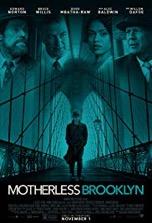
Starring: Edward Norton
November 2019
Warning! This is NOT a movie review. This is a critique of the film. Intended to initiate a dialogue, the following analysis explores various aspects of the film and may contain spoilers. Views are my own and elaborate on comments that were originally tweeted in real time from the back row of a movie theater @BackRoweReviews. For concerns over objectionable content, please first refer to one of the many parental movie guide websites. Ratings are based on a four star system. Happy reading!
Based on the novel of the same name by Jonathan Lethem, Motherless Brooklyn is a neo-noir set in NYC during the 1950s. It’s a tale of murder, greed, scandal and political corruption. Some things never change.
The film opens with Lionel Essrog (Edward Norton), a private detective afflicted (or blessed) with Tourette’s Syndrome, assisting his boss, Frank Minna (Bruce Willis), with an important case. Things go sideways when Frank is taken for a ride, shot in the stomach and dumped in an alley. Frank’s final words not only hint at the identity of his murderer, they also blow the lid off a high-level political scandal.
As he begins unraveling the tangled web of graft, Lionel meets Laura Rose (Gugu Mbatha-Raw), an attorney who’s advocating for the scores of minority families that are being forced out of their homes to make way for new housing developments. Lionel also encounters Paul Randolph (Willem Dafoe), a disgruntled engineer who implicates his brother, Moses (Alec Baldwin), as the chief architect of the unlawful land grab. These clues edge Lionel ever closer to the truth behind Frank’s death…and, as we learn in the opening sequence, once Lionel starts pulling on a loose string, he just can’t stop.
Due to the movie’s excesses, it’s difficult to remain impartial while evaluating it. On the one hand, Motherless is a gorgeous film (Norton’s deft direction beautifully captures the look and feel of the 50s milieu) with superb acting from its scintillating cast and period appropriate production elements—sets, props, clothing and coifs are all crafted with excellence. On the other hand, the movie is loaded with foul language (including over 60 F-bombs) and crude speech from one set of credits to the other.
It’s unfortunate that the movie’s unsavory dialog sullies the worthwhile facets of its story. Its R rating also prevents a broader audience from experiencing the movie’s remarkable central performance. Norton’s neck snaps and sudden outbursts never feel forced or rehearsed and are thoroughly convincing…an Oscar-worthy turn.
Lionel’s condition serves as a wild card element and produces sympathy in other characters (and the audience) when he apologizes for his behaviors (“I’ve got a condition…makes me say funny things”). Lionel’s ticks and quirks are the most interesting part of the movie. The same story with an average Joe detective would’ve made for a much duller film.
In adapting the screenplay, Norton borrowed story devices from two of the finest movies ever made: Chinatown (1974) and Citizen Kane (1941). Even though they take place on opposite coasts and are separated by a couple decades, Chinatown and Motherless both feature subplots involving political malfeasance. However, while the dispute in Chinatown concerns the theft of water, the civic upheaval in Motherless centers on the illegal appropriation of land.
Unlike Chinatown, there’s a racial element in Motherless, since the people being forced from their homes are largely Blacks and Latinos. One character refers to the city’s renovation efforts as “a program for Negro removal,” which hints at a systematic relocation (and perhaps even genocide).
Norton added the character of Moses Randolph to Lethem’s original cast of characters. Randolph is based on Robert Moses, a controversial city planner who lived in NYC during the mid-20th century. Orson Welles also modeled his main character in Kane after a real-life figure: many feel that Charles Foster Kane was a thinly-veiled analog of newspaper mogul William Randolph Hearst. Norton’s use of the name Randolph would seem to be a tip of the hat to Kane.
One of the most poignant scenes in the movie is when Paul tells Lionel that his brother, Moses, is part of a “shadow branch” of our government—no one voted him in and no one can vote him out. Moses is the exemplar of the type of unelected bureaucrat that’s ruining our country. He’s completely remorseless over uprooting communities and honestly thinks his efforts are going to make things better for future generations.
Moses believes that real power is when “not one person can stop you.” This proves, beyond question, that Moses has no compunctions about operating above the law. So steeped in narcissism and egomania is Moses, that he just gives a haughty smirk when someone burns an effigy of him at a rally with a sign that reads “Moses the Dictator!”
Paul is a man of good conscience, but he’s afraid of his brother. In the end, only Lionel has the fortitude to confront Moses. A person willing to stand up for what’s right also describes J.J. “Jake” Gittes (Jack Nicholson) in Chinatown, as well as Will Kane (Gary Cooper) in High Noon (1952).
In the end, the movie is a well produced period piece with superb acting and directing. Motherless is a slow boil, hard-boiled crime yarn with flourishes of high art (the movie’s climax crosscuts between action in a taxi, a subway and a jazz club, where the band provides vigorous accompaniment for the entire sequence). It’s also a story that’s uber-salient with what’s transpiring in our government at present.
Early buzz for the film seems to indicate its potential to be in the hunt for Oscar’s top prize. Sadly, any accolades or awards the film receives will only perpetuate its objectionable content.
Lionel describes his condition as having glass in his brain. After enduring nearly two and a half hours of slow pacing, murky plotting and incessant swearing, I know exactly how he feels.
Instant classic or instantly forgettable? The jury is out.
Rating: 3 1/2 out of 4
Coco (PG)
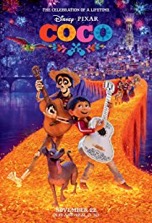
Starring: Anthony Gonzalez
November 2017
What follows is the full-length review based on comments that were originally tweeted in Real-time from the back row of a movie theater @BackRoweReviews. Though efforts were made to tease rather than ruin this movie’s memorable lines and moments, some spoilers may exist in the following evaluation. For concerns over objectionable content, please first refer to one of the many parental movie guide websites. Ratings are based on a four star system. Happy reading!
For their latest animated adventure, Disney/Pixar has selected main characters of a different kind. Instead of focusing on toys, cars, fish, robots or insects, they’ve returned to the world of people. However, not all of these people are alive. No, the animation studios haven’t gone all zombie on us (although, how cool would that be?). Focusing on the Mexican people and their Day of the Dead holiday (Nov. 1&2 annually), the studios have given us a glimpse of what life is like in the Land of the Dead. The story focuses on Miguel (Anthony Gonzalez), a young boy who wants to be an entertainer like his idol, Ernesto de la Cruz (Benjamin Bratt). Performing at the local talent show can help launch Miguel’s career, but first, he must borrow a guitar. But not just any guitar…the signature guitar that Ernesto played during his heyday, before the bell tolled and he met an early demise. Since he must ask for permission to play Ernesto’s guitar, Miguel embarks on a journey to the other side. Once Miguel has crossed the petal covered bridge that connects both worlds, he sets out to find Ernesto among the teeming masses of the macabre metropolis. As he navigates the Land of the Dead, Miguel encounters Hector (Gael Garcia Bernal), a lanky, fun-loving skeleton man who serves as both humorous sidekick and voice of reason for Miguel. Despite his seemingly silly persona, Hector holds a secret that literally busts open the story like a smashed piñata. Coco’s explosion of color rivals the visual vibrancy of the Finding films. Though certainly a marvel in its own right, Coco’s prismatic palette pales in comparison to its brilliant plot, which is chock-full of colorful characters and meaningful moments. This is the studios’ first attempt at spotlighting the customs and values of a minority culture. Director Lee Unkrich and his team of writers wisely avoided populating the story with clichéd characters and worn-out stereotypes. This is a deep dive into the hearts and minds of a people devoted to artistic expression, exuberant celebrations, fervent spirituality and, above all, the love of family. We’re treated to some traditional and modern Latin music including “Remember Me,” a top-tier, tear-jerker that should be a shoo-in for Oscar’s Best Song. Despite the fact that most of the movie works like magic, Coco has a fatal flaw—it borrows too heavily from other sources. The film mirrors Back to the Future in several key areas. Like Marty McFly (Michael J. Fox), Miguel wants to be a famous guitar player. Another point of comparison is that Marty and Miguel both travel through time (actually, the Land of the Dead probably exists outside of time, but close enough). Also, Marty and Miguel frequently reference family photos to learn clues about their family history and identity…and very existence. Ironically, the most obvious instance of plot theft in the story involves another Pixar movie. The trajectory of this film’s villain is so similar to that of Up’s Muntz, the only word that comes to mind is derivative, which I never thought I’d use to describe a Pixar movie. The film has problems with its premise too. For instance, is it really necessary to travel to the world beyond just to borrow a guitar? Admittedly, these are minor grievances in a movie that thoroughly entertains. The film subtly tempers its follow-your-dreams theme with a cautionary tale regarding the dangers of hero worship. Unkrich does a remarkable job of making morbid subject matter relatable and even, at times, humorous (e.g. the nude skeleton portrait scene). In the final analysis, Coco is rich in culture and character, sight and sound. It’s also a heartwarming tale of multigenerational connection between a young boy and his grandparents. Coco delivers an emotional wallop at the end, just to remain consistent with Pixar’s MO of leaving its audience in tears. But this time they’re tears of joy. Over a family reunion. Over fulfilled dreams. And over a young boy returning home…to the Land of the Living.
Murder on the Orient Express (PG-13)
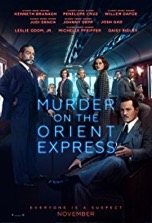
Starring: Kenneth Branagh
November 2017
What follows is the full-length review based on comments that were originally tweeted in Real-time from the back row of a movie theater @BackRoweReviews. Though efforts were made to tease rather than ruin this movie’s memorable lines and moments, some spoilers may exist in the following evaluation. For concerns over objectionable content, please first refer to one of the many parental movie guide websites. Ratings are based on a four star system. Happy reading!
The standard opening would say something like: “Based on the novel by Agatha Christie…” In this case, it’s more accurate to say: Loosely based on the novel of the same name by Agatha Christie, Murder on the Orient Express is a modern retelling of Christie’s seminal mystery yarn. Much to its detriment, this version of Christie’s magnum opus is more concerned with casting Hercule Poirot (Kenneth Branagh) as a superstar sleuth in the mold of Sherlock Holmes than as the humble, working man’s detective from the source material. The “loosely” argument is bolstered by the fact that director Branagh makes several significant alterations to the literary classic, the first of which comes during the movie’s opening when Poirot solves a mystery in the style of Holmes. Unfortunately, the case is exceedingly conventional and the specifics are muddled. We have no interest in the people involved in the whodunit since we just met them and could care less about the caper itself because we have no investment in its outcome. The whole sequence is gratuitous since it was designed solely for the purpose of demonstrating how marvelous a detective Poirot is…which we’ll figure out anyway once the titular murder has been committed. These are wasted minutes that could’ve been used for developing back stories or laying out the details of the homicide—both of which are cursory to the extreme in Branagh’s Murder. The procedural elements are breezed through—the clues (handkerchief with an embroidered H, pipe cleaner, broken watch and, later, scarlet kimono) are discussed in less than 30 seconds and the specifics of the murder (i.e., number of stabs, where and how severe the blows were, etc.) only take up about a minute of screen time. So what does Branagh spend the balance of the film on? Good question. It certainly isn’t on character development. Indeed, we get to know these train passengers far less than their counterparts in Sidney Lumet’s version of Murder (1974). That iteration of Christie’s book also had a decorated cast (Albert Finney, Sean Connery, Vanessa Redgrave, Michael York, Ingrid Bergman, et al.), but it could be argued that individuals in that movie were two-dimensional too. Branagh spends a few minutes of screen time on establishing shots of the train rolling along the European countryside. It’s a nice add since the technology didn’t exist in the 70s to create these sweeping, aerial landscape shots. However, the double-edged sword of technology is that it draws attention to itself. Here, our first impression is, “Wow, gorgeous vista,” and then our second thought is, “And it’s been rendered to death by CG artists.” As for the cinematography, Branagh makes the most of the cramped train set by using clever camera angles. Branagh employs a high angle shot twice—once when the body of loathsome Ratchett (Johnny Depp) is discovered and then during the examination of the corpse. One instance would’ve been sufficient, twice is overkill. Plus, both shots are long takes, which are more enjoyable for their artistic achievement than for their viewing pleasure. Another “loosely” item is the scene where Arbuthnot (Leslie Odom Jr.), who’s a doctor instead of a colonel in this rendition, shoots Poirot. Though his motivation is to protect Mary (Daisy Ridley), the good doctor earlier averred that he couldn’t harm a fly. This is the kind of inconsistency that drives Poirot, and savvy spectators, mad. Of course, the shooting serves the story as both a red herring and an action interlude, so its inclusion is understandable, if unacceptable. The next scene also has plenty of new material in it. For starters, none of the characters leave the train in Christie’s book. Here, all of the suspects sit at a table (where did it come from?) inside a train tunnel: the obvious visual antecedent here is da Vinci’s “The Last Supper.” This is the setting where Poirot solves the case, albeit in a less streamlined and cogent manner than in the book and earlier film. In particular, the two possible solutions aren’t explained very clearly. A compelling new scene involves Poirot offering himself up as a sacrificial lamb so that the guilty parties can go free. Poirot places a gun on the table, which affords the conspirators an opportunity to silence him. In a shocking twist, Mrs. Hubbard (Michelle Pfeiffer) grabs the gun and tries to off herself. Though not without entertainment value, this story embellishment falls flat when we learn that the gun is empty, making the whole sequence a pointless exercise, other than to generate some faux tension. Once the case has been solved and the train freed from the snow drift, the movie should come to an end. But the denouement is dragged out so that we can observe Poirot heading off to his next case—again, it’s obvious, and somewhat pathetic, that Branagh is so determined to portray Poirot as an in demand, top-shelf detective when he knows that the Belgium sleuth carries none of the clout or name recognition (at least in America) as Holmes, Spade, Marlowe or Hammer. Michael Green’s adaptation of Christie’s book is disappointing on so many levels there isn’t even a word to describe how poor his efforts are. Everything in the plot is done hastily. Like a runaway train, the story steamrolls along to its inevitable, predictable resolution. The elegance of Christie’s tale is in how it selectively dispenses clues and gradually reveals the motivations of its diverse, yet unified, characters. All of this is lost in Branagh’s Murder, which, in the end, is just a Reader’s Digest version of Christie’s masterwork. Murder’s expedience is its undoing. That’s a bitter reality since the film wastes a fine central performance by Branagh (which is much more enjoyable to watch than Finney’s, in my opinion). It’s also sad that the considerable talents of the rest of the spectacular cast were wasted on such perfunctory material. Ironically, that’s an even bigger crime than the one committed in the movie.
Blade Runner 2049 (R)
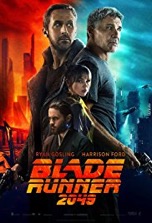
Starring: Ryan Gosling
October 2017
What follows is the full-length review based on comments that were originally tweeted in Real-time from the back row of a movie theater @BackRoweReviews. Though efforts were made to tease rather than ruin this movie’s memorable lines and moments, some spoilers may exist in the following evaluation. For concerns over objectionable content, please first refer to one of the many parental movie guide websites. Ratings are based on a four star system. Happy reading!
A sequel 35 years in the making, Blade Runner 2049 is a respectable, if not orbit-altering, follow-up to Ridley Scott’s 1982 cult classic, Blade Runner. There are several key production aspects to discuss right up front: First, even though Scott is a producer on the film, he didn’t direct it. That honor fell to Denis Villeneuve, who helmed the visually stunning, style-over-substance Arrival last year (more on the movie later). So why didn’t Scott direct the sequel himself? Unknown. What is known is that Villeneuve does a remarkable job of marrying his visual style to the aesthetic Scott established in the first film. The latest iteration of Runner’s future shock society is both a logical extension of the original’s style and a tribute to the cosmopolitan, seedy, neon world brought to life by Scott and cinematographer Jordan Cronenweth. Another keen production decision was to show a progression of design elements to reflect the sensibilities of the era—the first film was set in 2019, thirty years earlier than the sequel. If possible, things are even more dingy and rundown in the new film. Also, the showgirl sexploitation in the original has been digitized and supersized—a ten story tall nude woman interacts with oglers on the street. Just as our society has made a giant out of the porn industry since 1982 (due in large part to the internet), so too have the inhabitants of Runner’s neo-noir dystopia. Another scene depicts huge hovering trash trucks dumping garbage onto a vast plain, filled with segregated piles of trash a la the opening of WALL-E (2008). The environmental message here is clear. This setting becomes the locus of a brief, yet intense, action scene involving Ryan Gosling’s Officer K (not to be confused with Agents J and K from the Men in Black movies). Ironically, Gosling’s co-star had a memorable trash sequence of his own forty years earlier in Star Wars (1977). That co-star, of course, is Harrison Ford, who reprises his role as Rick Deckard, the central character from the first film. There’s good and bad news here. The good news is that Ford is extremely effective in his scenes, especially during the denouement (see below). The bad news is that Ford doesn’t show up until the movie’s halfway mark. Gosling and Ford appear to have good screen chemistry, but the sample size of their shared scenes is so small, it’s difficult to positively affirm that observation. Another original cast member, Edward James Olmos, appears here too. Sadly, Olmos is only in one scene and looks like Colonel Sanders with his gray mustache and pointed goatee. Other cast members shine in limited roles, such as: Dave Bautista, Jared Leto, Robin Wright and Mackenzie Davis. The production elements are finely crafted and are wholly immersive. Particularly eye-catching are the interior sets, which are lit with otherworldly hues or mesmerizing water ripple effects. If there’s one area of the movie that doesn’t succeed it’s the overlong, onerous, obtuse screenplay by Hampton Fancher and Michael Green (based on the story by Philip K. Dick). In general, the “show-don’t-tell” cardinal rule of writing should be followed to the letter. Here, that maxim is taken to the extreme as characters are often shown in contemplative poses or gazes for so long, you can get your popcorn refilled and still not miss anything. True, a plot should never be spelled out, but the audience needs something to go on. A string of scenes that “show-show-show” with no dialog, exposition or contextualization, can become tedious, as exemplified by this film. Granted, the pressure to follow up the original film with another instant classic must’ve been oppressive for the writers, but the insistence on skewing so far to the art side of the spectrum, while forgetting that a broad swath of the audience was drawn to the film for its commercial elements, was a serious miscalculation. Much like Villeneuve’s Arrival, Runner 2 has sacrificed meaning and accessibility for style points. Was the tradeoff worth it? Time, and ticket stubs, will tell. The seaside struggle is an intense sequence, but certainly isn’t the nail-biting climax the film needed to drive the story home. However, the final series of scenes are the finest in the film and help to boost its rating far above that of the refuse heaps of standard movies. Villeneuve stages some symbolic and synergistic parallel action sequences between Officer K and Deckard at movie’s end. K lies back on concrete steps as snow (in L.A.) sprinkles down around him. It’s a gorgeous shot, but I half expected Gosling to make a snow angel—perhaps he did in an outtake. The scene inside the building, where Deckard meets his daughter, Ana Stelline (Carla Juri), for the first time, is much more meaningful. Deckard places his hand on the glass wall that separates him from his daughter. It’s a moving scene of connection despite the division of walls and years. Ironically, we saw this same pose in another 1982 sci-fi release, Star Trek II: The Wrath of Khan, when Kirk holds his hand against the Plexiglas wall that isolates him from a dying Spock. Now would be an appropriate time to mention that Ford is a tremendous “hand” actor. He channels enormous energy into scenes where he points an accusatory finger at someone (The Fugitive and Clear and Present Danger) and is also marvelous at grabbing and using objects around him (numerous instances in the Indiana Jones films, especially the idol scene in Raiders of the Lost Ark). Here, the simple action of placing his hand on a translucent wall carries with it tremendous power—the scene literally sent chills up my spine. It was the first time in the film I felt any kind of emotion. Sadly, it was the final shot of the movie. In the end, there can be no doubt that Runner 2 is a worthy film in its own right and that it has moved the series forward without being an embarrassment to the original. However, Runner 2, like its robotic replicants, has little emotion and heart. Still, Runner 2 is a beautiful film that bears repeat viewings to uncover all of its hidden meanings and Easter eggs. Speaking of which, Ana is creating snow with her hands when Deckard walks in to meet her. Is this the same snow that’s drifting down onto Officer K? And if so, is his character real? Or just dreaming? Of electric sheep?
Jack Reacher: Never Go Back (PG-13)
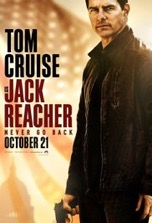
Starring: Tom Cruise
October 2016
The below comments (in Black) were originally tweeted in Real-time from the back row of a movie theater and appear @BackRoweReviews. Though efforts were made to tease rather than ruin this movie’s memorable lines and moments, some spoilers may exist in the following evaluation (in Red). For concerns over objectionable content, please first refer to one of the many parental movie guide websites. All ratings are based on a four star system. Happy reading!

“One guy took ‘em all out in like seconds.” #JackReacher
90 seconds until a bad cop is arrested. #MagnificentProphecy
“I woke up one morning and the uniform didn’t fit.” #CareerChange
“I don’t like being followed.” Yep, that’s daddy’s little girl.
“Welcome back to the Army, major. You’re under arrest.” #PlotTwist
“It’s time we stop running, and start hunting.” Yeah! #GameOn
“You’re very intense.” #JackReacher
“All you contractors go to the same barber?” LOL #GreatLine
“Never underestimate the charm of a seedy motel.” Ha! #SeedyMotel
“I don’t like being followed.” Hmm. Seems to me I’ve heard that before.
“People talk to me. It’s a thing.” Nice tip of the hat to #HowIMetYourMother. #ItsAThing
“Now the numbers add up.” #PureOpium
Bad guy gets hosed by Danika.
“It means we’re dead already.” Daddy/Daughter code.
Girl’s got #PhoneDrop skills.
Final analysis: a solid follow-up to the first film with some new characters and challenges.
Rating: 3 out of 4. Drags at times, but the action scenes are well executed. Cruise keeps cruising.
Based on Lee Child’s novel series, the first Jack Reacher (2012) movie introduced audiences to the title character, an anti-establishment, off-the-grid, ex-military drifter whose MO is cracking skulls while defending the little guy from evildoers. The follow-up film, Jack Reacher: Never Go Back, is a diverting, if not life-altering, sequel that finds Reacher (Tom Cruise) on the run from the military he once served as well as from his past; one of his former conquests had a daughter and is claiming that he’s the father…fourteen years after the supposed deed. To a former Special Forces lone wolf like Reacher, outrunning the MPs is a far less daunting challenge than raising a teenager. Fortunately, he gets some significant support in dealing with his alleged daughter, Samantha Dayton (Danika Yarosh), from a falsely accused Army officer, Major Susan Turner (Cobie Smulders). Together, Reacher, Turner and Dayton try to stay one step ahead of their pursuers while attempting to uncover an illegal arms racket inside the military, which will exonerate Turner. The story’s climax features a protracted chase sequence through the crowded streets of New Orleans during Mardi Gras—an action set piece that’s been done to death by now but somehow still manages to entertain. The scenes where Reacher says goodbye to his new-found friends are touching without being overly schmaltzy, which is consistent with Reacher’s laconic persona. The movie closes with Reacher thumbing a ride on the side of a highway—moving on to his next adventure like an Old West cowboy heading off into the sunset. Aside from some new characters and a few new scenarios, there really isn’t anything here that wasn’t in the previous movie. That’s not necessarily a bad thing for fans of the first film who just wanted more of the same in the sequel, but those seeking something other than just a reheated story may find this film wanting in the creative department. On the plus side, the acting is solid across the board: Smulders’ pluck is a plus as is Yorosh’s naïve self-assuredness. Cruise is satisfactory in the title role but doesn’t bring anything extra to the part this time, he just hits his marks and delivers his lines…and runs. Running has become a staple of every Cruise film; partly because he’s good at it and partly because a certain segment of his fan base really enjoys it. Here, Cruise is joined by the svelte Smulders on a few of his mad dashes—just to provide equal opportunity for ogling spectators. Although there are a few witty one-liners in the film, like Reacher’s pre-clobber comment about a thug’s barber, the proceedings are mostly serious and could’ve used more humor to counterbalance the dramatic and action beats. The fight sequences, coordinated by director Edward Zwick, are top-notch, yet feel like a retread of the multi-assailant melees seen in the prior movie. Even though Reacher 2 is an adequate sequel, has it done enough to extend the franchise into a trilogy? And if so, will audiences even show up for a third installment, or have they already decided to Never Go Back?
Arrival (PG-13)
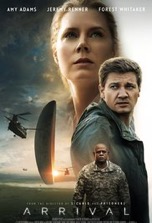
Starring: Amy Adams
November 2016
The below comments (in Black) were originally tweeted in Real-time from the back row of a movie theater and appear @BackRoweReviews. Though efforts were made to tease rather than ruin this movie’s memorable lines and moments, some spoilers may exist in the following evaluation (in Red). For concerns over objectionable content, please first refer to one of the many parental movie guide websites. All ratings are based on a four star system. Happy reading!

“We are so bound by time...by its order.” Like it or not. #Time
A sad departure at the film’s outset.
“I would need to be there.” Congratulations, you just volunteered.
The #Sanskrit word for war? It’s all #Greek to me.
“Dazzle them with the basics.” Standard methodology.
“Maybe we should try talking to them before throwing a math problem at them.” Ha!
This gigantic obsidian spheroid puts #2001’s #Monolith to shame. #2001ASpaceOdyssey
This gravity switch is a #MindTrip.
The #Kangaroo story is amusing.
“What is your purpose on Earth?” Love the way she teases out this sentence. Good #Logic.
“Now that’s a proper introduction.” I’ll say. #TentacleTouch #GreatLine
This smoke ring language is fascinating. #SmokeRing
“A logogram is free of time.” #Heptopod language.
“Are you dreaming in their language?” Conversation starter. #Logogram
“Use weapon.” Uh-oh! #Logogram #Heptopod
“Many become one.” The nations must unite.
“Louise sees future.” #PlotTwist
Hannah is a #Palindrome. So is radar. #Linguistics
“It was meeting you.” Ian scored major points with that line.
Final analysis: a thought-provoking “first contact with aliens” yarn that reveals the best and worst in humanity.
Rating: 3 out of 4. A visual marvel with solid acting. The atmospherics trump character development. Trite ending.
If a movie is only satisfactory for three-fourths of its running time, is it still a quality entertainment? Sure, but it’s also an egregious waste of potential. That last phrase perfectly describes Arrival since the first three-fourths of the film are taut, thrilling and saturated in mood and mystery, while the last quarter is an unwieldy, uninspired mess. To its credit, the movie doesn’t waste its time on drawn-out alien vessel appearances or FX fanfare sequences, like many alien assault flicks in the mold of Independence Day (1996). It’s clear from the outset that Arrival is a different kind of space invader film since it eschews the traditional action-packed opener in favor of a more moody and intimate prelude, introducing the first glimpses of the alien ship not in big budget special effects shots, but in streaky news footage airing on a living room TV. The story is infused with palpable tension as the military and scientists (never a good combination) scramble to determine if the recently arrived mother ships, which are presently stationed above a dozen random positions around our planet, are friendly or malevolent. Vital to the Save the Earth campaign is the inclusion of a communications cognoscente, but the world’s foremost authority on the subject has unceremoniously quit the project, presumably because his insurance doesn’t cover “Accidental Death by Space Aliens.” Rather than call or Skype the next qualified person on the list, Colonel GT Weber (Forest Whitaker, who is little more than set dressing in the movie) flies out for a face to face with the possible replacement and requests, rather than demands, that individual’s participation—apparently the fact that our planet can be blown to bits at any moment has no effect on the nerves-of-steel war dog. Fortunately for us, Dr. Louise Banks (Amy Adams) is available to join the global coalition of experts as her students haven’t attended her Linguistics class at the university ever since the aliens arrived (no dedication to higher education these days). Louise meets theoretical physicist Ian Donnelly (Jeremy Renner) and the sparks immediately start flying, triggered in part by their English versus Math verbal sparring match and in part by their obvious attraction to each other. Louise and Ian are tasked with establishing communications with the aliens, a tall order since neither of them remembered to pack a universal translator. The team’s initial visit to the alien ship (a colossal, obsidian spheroid hovering vertically in midair like a supersized version of 2001’s monolith) is a mind-bending, nape-prickling affair that effectively captures what it must feel like to make first contact with a bizarre alien species—this movie features gigantic heptapods with petal-like proboscises that emit puffs of black soot which congeal into circles a la Gandalf blowing smoke rings in The Lord of the Rings: The Fellowship of the Ring (2001). The novelty of these alien encounters wears off with successive visits (why so many?), but the intrigue heightens when our heroes learn the nature of the alien circles. So far, so good. Arrival, especially in the early goings, is reminiscent of The Day the Earth Stood Still (the original from 1951, not the schlocky remake with Keanu Reeves in 2008), which is widely regarded as one of the finest—and highly evolved—sci-fi pictures ever made. Though certainly in good company there, Arrival squanders its sure-footed setup with a standard, schmaltzy ending, particularly in how the earlier sparks between Louise and Ian are kindled into a full-fledged romance. This storyline feels rushed since the characters graduate from arguing co-workers to loving, dedicated parents in one convenient leap into the future. The jump in time is jarring and is further exacerbated by the fact that we learn very little about the star-crossed couple since the film’s otherworldly cinematography and alien atmospherics constantly overshadow what little character development can be found here (after all, the alien vessel is the star of the show). The flash-forward flubs also extend to the movie’s gimmicky resolution: side character General Shang (Tzi Ma) provides Louise with the solution to the alien riddle in a sequence so ridiculous it recalls the antics in Bill & Ted’s Bogus Journey (1991) where the titular twosome merely think of an action in the past that will thwart their adversary in the present. However, as awful as that story device is, the mishandled ending isn’t the only problem with the film. For instance, the aliens seem to comprehend concepts far more complex than “weapon,” so their nearly disastrous misunderstanding of the word seems more than a little contrived. Another narrative misstep is Ian’s out-of-the-blue voiceover narration midway through the film. Besides being overly expository, this narrated section is incongruous with the rest of the film and just feels odd since it shifts the POV away from the main character (Louise) and toward the secondary character (Ian). And then, to get really nitpicky, there are several story snafus, such as: how can a non-linear alien species know that humans will assist them 3,000 years into the future? Are they sure it isn’t 2,999 years from now? Or 3001? Further, why would these aliens even need our help since they’re so technologically advanced from us? Also, why do the creatures communicate with circles…seems a tad trite since we already associate (crop) circles with aliens, right? And how can Louise’s vision at the beginning of the film even occur since she doesn’t possess the capacity to look into the future at that point? Louise’s ability to gain knowledge from the future that will help us in the present which will preserve our future is a time paradox so convoluted it would give John Connor a migraine. These are niggling details, to be sure, but the sheer number of them reveals just how porous the plot is and prevents the movie from achieving maximum liftoff. Like a skilled magician, director Denis Villeneuve (Prisoners, 2013) has cleverly disguised his tenuous story with a style over substance sleight of hand along with an obfuscating display of temporal razzle-dazzle (in the Chicago sense of the word). In the end, Arrival’s arrival is well executed, but its departure needs some work. Good thing we have the next 3,000 years to get the sequel right.
The Girl on the Train (R)

Starring: Emily Blunt
October 2016
The below comments (in Black) were originally tweeted in Real-time from the back row of a movie theater and appear @BackRoweReviews. Though efforts were made to tease rather than ruin this movie’s memorable lines and moments, some spoilers may exist in the following evaluation (in Red). For concerns over objectionable content, please first refer to one of the many parental movie guide websites. All ratings are based on a four star system. Happy reading!

Rachel drawing in a notebook is different than in the book.
I applaud the writer for maintaining the POV juggling from the book. We’ll see how well it’s executed.
Rachel’s hands shake while applying lipstick. #Alcoholic
Powerhouse monologue in the bathroom. #EmilyBlunt
An actual AA meeting...merely referenced in the book.
“I ride the train.” Unusual occupation. #TicketsToNowhere
Bizarre depictions of people in the gallery paintings. #FracturedIdentities
“Don’t make it impossible for us to work together.” Too late.
“Your wife hit me on Friday night.” That’s different from the book.
“I’m afraid of myself.” With good reason, Rachel.
“I fell asleep. I let her go.” Horrific!
“Rachel is a sad person.” Not as sad as you, Tom.
#LisaKudrow holds an important key to Rachel’s blackouts.
Megan wants to go to the woods with Tom. Bad choice.
“In a way you killed her.” Nice try, Tom. #GuiltTrip
Anna has a heart shaped blood stain on her white sweater. Ironic.
Final analysis: a faithful adaptation that gets the broad strokes right, if not the fine details.
“There’s nothing so painful, so corrosive, as suspicion.” My favorite line from the book. #Freebie
Rating: 3 out of 4. Solid acting and writing are squandered by middling direction. Such potential here.
Based on the popular book of the same name by Paula Hawkins, The Girl on the Train tells its sordid story from the perspectives of three women whose lives are intertwined in ways that could only be feasible in a novel…or Hollywood production. The movie arrives less than two years after the book was published (January of 2015) and comes courtesy of screenwriter Erin Cressida Wilson and director Tate Taylor. Sparing you a long litany of book-to-movie comparisons, I’ll just say that despite numerous narrative alterations (like the accelerated revelation of Rachel’s employment status), the story remains fairly faithful (unlike its characters) to the source material. Some changes work extremely well: the decision to omit the physical relationship between Rachel (Emily Blunt) and Scott (Luke Evans) is a plus since the mere implication of impropriety works wonders dramatically and since the two of them hooking up was dubious from the start. On the flip side, there are several plot breakdowns in the film, most notably the scene where we learn Megan’s (Haley Bennett) fate, which is bracketed by Rachel losing and regaining consciousness. Is this climactic moment a dream, a hallucination or some mental reconstruction of how Rachel thinks the murder occurred? Since the answer is none of the above, this deviation from the POV structure that was established from the opening moments of the movie, muddies the plot stream and creates confusion during the most crucial scene in the film. It’s precisely this sort of story inconsistency that prevents the cinematic Train from achieving what Hawkins did so masterfully in her novel, which only reinforces the long maintained sentiment that the book is always better than the movie. So then, just as the characters attempt to learn the identity of the murderer in the movie, let’s seek to discover who’s at fault for the film’s flawed execution. We certainly can’t point a finger at the acting. Blunt (though far more petite than the novelized Rachel) delivers an authentic portrayal of the low ambition alcoholic, whose frequent blackouts makes her testimony of a perceived crime dubious at best. The supporting players—Rebecca Ferguson, Justin Theroux, Laura Prepon, Allison Janney, Lisa Kudrow, etc—all deliver fine performances too. Wilson does an admirable job of adapting Hawkins’ novel—no small task with its large cast of central characters, multiple perspectives, jumping timelines and carefully constructed, time-released revelations—so her efforts can’t be criticized either. Although the action moves from England in the book to the northeastern U.S. in the movie, the story works well enough in either setting, so no drawback there. Ultimately, the culprit for the film’s underachievement is its directing. One wonders why such a high profile, and potentially highly lucrative, property was turned over to a virtual unknown (Taylor’s only prominent films are 2008’s The Help and 2014’s Get on Up)? Why wasn’t David Fincher (Gone Girl), Denis Villeneuve (Prisoners) or another proven director tapped to helm such a multivalent, psychologically complex thriller? Taylor’s direction fails to plumb the depths of Hawkins’ nuanced characters and, instead, settles for a perfunctory, skin-deep methodology. This inability to tap into genuine human emotions and motivations is a massive missed opportunity since Hawkins’ yarn is so immediate and so rich in character…and so Hitchcockian (the story’s inciting incident is essentially Rear Window on a train). As was conveyed in many of Hitchcock’s films, all spectatorship is voyeuristic in nature. As such, we’re equally complicit in Rachel’s transgressive meddling when she peers out the train window and when she inserts herself into the lives of complete strangers. The film’s saving grace is its ability to confront us with this key concept from the book. However, in the end, Train is merely an adequate adaptation of the novel and will underwhelm its audience, especially those who’ve read the book. Well, I’d love to stay and chat some more about this film, but this is my stop.
Allegiant (PG-13)

Starring: Shailene Woodley
March 2016
The below comments (in Black) were originally tweeted in Real-time from the back row of a movie theater and appear @BackRoweReviews. Though efforts were made to tease rather than ruin this movie’s memorable lines and moments, some spoilers may exist in the following evaluation (in Red). For concerns over objectionable content, please first refer to one of the many parental movie guide websites. All ratings are based on a four star system. Happy reading!

“Are we going to do this?” Please don’t.
“Great leaders don’t seek power.” That rules out everyone running for president. #Election2016
The #RunUpTheWall sequence is exhilarating.
Why leave the beautiful forest for a radiated wasteland?
“The sky is bleeding.” #AcidRain
Hope they brought lots of drinking water. That red stream looks a bit dicey. #LiquidRadiation
I wonder if they have a spy camera inside the decontamination room. #PeepShow
“They’ve grown up watching you.” The #Voyeurism of spectatorship. Shades of #TheTrumanShow.
#Tris is “pure.” I could’ve told you that.
“Help me save the world.” What’s the catch?
Four forays into the #Fringe. #KidCollecting
Off to #PureCity. Looks like #Coruscant.
“Chicago might forget its own name.” #MassAmnesia
Reddish gas fills the streets of #Chicago. Oh wait, it’s just smog.
Final analysis: a logical extension of the earlier films that’s quite a departure thematically.
The first truly #SciFi chapter in the saga with amazing technology and salient social commentary.
Rating: 3 out of Four stars. A satisfactory series capper that leaves us with plenty to mull over.
So it turns out this isn’t the final film in the series after all—Ascendant is slated for release next year. My bad. Guess I should’ve known that this type of popular YA book to movie series, a veritable cash cow for a studio like Lionsgate, would be milked for all it’s worth. Show business is a business, after all. For those unfamiliar with Veronica Roth’s teen novels of the same name, the main theme of the Divergent series is that a well intentioned social experiment can, and often times will, go horribly wrong. The adapted screenplays based on Roth’s works capture her cynical eye toward the future and her patented brand of cautionary tale which decries the dangers of any socialist structure similar to Adolph Hitler’s Germany in the 30s and 40s as well as predetermined societies where individuality is absorbed into a rigid caste system a la the one in Aldous Huxley’s Brave New World (it must’ve been in the ether that I selected two historical figures with the initials A.H.). The previous two movies in the series focused on the exigencies of life in a post-apocalyptic world rife with political corruption, social upheaval and the requisite quotient of teen angst/romance. Fortunately, in the third film, Allegiant, the series has grown up as characters are faced with bigger challenges outside the wall that surrounds bombed out Chicago (maybe one of Trump’s descendants built it). The sequence where the characters scale the wall is not only a riveting action scene it’s also the incident that kick-starts the story; everything up to that point is merely dry exposition with remedial, redundant squabbles among factions in the derelict districts of the Windy City. From the moment Tris’ (Shailene Woodley) boot touches the radiated soil beyond the wall, the movie morphs into a top rate sci-fi yarn, complete with high tech trappings and scathing social commentary. The meticulous world-building that went into crafting the photorealistic “alien” landscape known as the Fringe, a scorched wasteland where sojourners must avoid polluted streams and acid rain, is first rate. The film’s lavish metropolises, especially the sleek Pure City (think Coruscant meets Apple Store), are appropriately futuristic in design and appointments and are a stark contrast to the slagheap environs featured in the earlier films. Advanced technology, like the drones, spy rooms and cloaking shuttle, are clever, forward-thinking tech concepts that add a great deal to the reality and visual vitality of the film. The new addition to the cast is duplicitous David, played to perfection by Jeff Daniels. His portrait of an antagonist with clear-cut goals and a believable motivation is absolutely superb. Daniels’ genuine, steady-handed performance not only provides the story with necessary urgency and focus, but also raises the bar for the other performers, especially Woodley, who’s grown as an actor with each successive picture in the series. Though each of the ancillary characters is given a unique assignment in the film, none of them are granted much screen time. Even main character Four (Theo James) is relegated to back burner status for much of the movie as he frets over Tris’ safety. However, Four is present for some of the movie’s most memorable action passages including the horrific child kidnapping sequence. As for other prominent cast members: Caleb (Ansel Elgort) learns how to be a voyeur, Christina (Zoe Kravitz) struts around looking tough and Evelyn (Naomi Watts) helps Peter (Miles Teller) initiate a plan to mass brainwash the citizens of Chicago in a sequence reminiscent of Scarecrow’s fiendish plot to terrorize Gotham City (also Chicago in Christopher Nolan’s trilogy) with his fear gas in Batman Begins (2005). Even though Allegiant leaves the door wide open for a sequel, it could’ve ended right here as a trilogy. In fact, I think it would’ve been satisfactory to conclude the series right here with some questions remaining and with its moral lesson still hanging in the desert air. We’ll have to see if prolonging the series was a good decision or not…from Allegiant’s performance at the box office so far, it looks like the series might be running out of steam. And speaking of steam, what keeps those trains moving 24/7?
Mr. Holmes (PG)
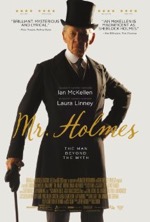
Starring: Ian McKellen
July 2015
This review was originally tweeted in Real-time from the back row of a movie theater and appears @BackRoweReviews. Though efforts were made to tease rather than ruin this movie’s memorable lines and moments, some spoilers may exist in the following evaluation. The original tweets appear in black, while follow-up comments appear in red. For concerns over objectionable content, please first refer to one of the many parental movie guide websites. All ratings are based on a four star system. Happy reading!

“It isn’t a bee, it’s a wasp. Different thing entirely.” The essence of distinctions.
And, as we learn in the film, wasps kill bees. Oh, and that bees leave their stingers in their victims while wasps leave painful welts.
“It’s usually about his wife.” Holmes teaches Roger the #ArtOfDeduction.
Actually, this is more life experience than deduction. If a man is hung up over something, 9 times out of 10 it’s a woman.
“And if I forget to make the mark?” Practical as ever.
The scene later in the movie, where we see the journal filled with black dots, is absolutely horrifying. The mind is a terrible thing to waste, especially when it’s one as brilliant as Holmes’.
Never heard of a #GlassHarmonica. I usually just rub my finger over the mouth of a drinking glass.
And, truthfully, I’m not even very talented at that.
“We do not like wasps.” Something the young and old can both agree on.
The relationship between Holmes and Roger is one of the movie’s many highlights.
“I prefer facts.”
As Dragnet’s Joe Friday would say, “Just the facts, ma’am.”
Holmes finds #PricklyAsh amid the horrific remains of Hiroshima.
Fascinating, and bitterly ironic, that a substance that improves memory should grow in an area of the world that many would choose to forget.
Holmes watches a movie based on one of his cases. His review: #PureRubbish.
Of course, since Holmes himself is fictional, the detective watching himself on the big screen is utterly ludicrous.
“I can’t remember.” Holmes like we’ve never seen him before.
We’ve seen Holmes in the throes of an addiction (Nicholas Meyer’s 1976 film The Seven-Per-Cent Solution) before, but never in the grip of Alzheimers. It’s a totally compelling, and heartbreaking, portrayal of a once indomitable private detective.
“A good son always does what his mother asks.”
Good advice for sons of any age.
“Don’t say everything you think.” #LifeLesson
If you don’t have anything nice to say, don’t say it at all. Remember that chestnut from your youth?
Burn, wasps. Burn!
Actually, other than Holmes’ poor memory, the wasps are the only antagonists in the film.
“My first foray into the world of fiction.” And it’s a good one.
And more factual (if fictitious) than Watson’s accounts, as we’re lead to believe by Holmes.
Final analysis: a deeply moving portrait of a once formidable detective in the throes of losing his faculties.
A totally unique take on the character and one that hits the mark, thanks in large part to its incomparable star.
Rating: 3 1/2 out of 4 stars. McKellen is mesmerizing in this first-rate, though slowly paced, #DraMystery.
One thing there’s always been an abundance of throughout film history is sequels, and one of the longest running series of all time spotlights London’s preeminent caper solver, Sherlock Holmes. The master detective has been portrayed in over 200 films by over 70 top tier actors, ranging from Basil Rathbone to Robert Downey Jr. Although characterizations have contained minor variations in mannerisms and style, Holmes has been played fairly consistently over the years: confident, irreverent and snobbish, with an encyclopedic knowledge and preternatural insight into human beings and the natural world around them. By contrast, something we’ve never seen before, until this film, is a Holmes who isn’t in complete command of his mental faculties. A Holmes with Alzheimers is just as compelling (perhaps even more so), than a kryptonite crippled Superman. Since Holmes’ greatest asset is his brain, his aggressive memory loss reduces him to a pitiable, tragic figure—a mere shadow of his former self. However, what makes this vivid character portrait even more fascinating is that even though Holmes’ memory is failing him, his powers of deduction are still razor sharp. So who could possibly pull off such a complex role while also infusing it with the necessary vulnerability, sagacity and…magic? Why, a living, breathing wizard, of course. Ian McKellen’s performance is a study in brilliance; he fits the part of the aging investigator so well that it seems as if he were born to play Holmes. The main thrust of the movie revolves around Holmes’ final case—the one that inexplicably sent him into early retirement when he had plenty of good sleuthing years still ahead of him. Snippets of that case are woven into the tapestry of the narrative in a series of flashbacks. Holmes, channeling his inner John Watson, puts pen to paper and tries to piece together the events of his concluding conundrum in narrative form. There’s one crucial detail of his initial investigation that evades Holmes’ every effort to isolate it inside the prison of his mind. This elusive clue becomes a MacGuffin of sorts and its eventual unveiling reveals a heartrending tragedy. The bitter knowledge that successfully solving a case doesn’t always guarantee a positive outcome for all parties involved drives Holmes from his flat on 221B Baker Street to a country cottage, where he hangs up his deerstalker hat for good. Whereas the intermittent vignettes of Holmes’ ultimate intrigue serve as the spine of the movie, it’s Holmes’ interactions with his housekeeper (Laura Linney) and her son Roger (Milo Parker) that grounds the movie and shows us a human side to the character that we’ve rarely, if ever, seen before. Though the pacing is slow at times, the insightful flashbacks and clever planting of clues should hold the attention of most audience members. Of course, the period accurate details, gorgeous locations and stellar performances should also keep viewers engaged and entertained throughout the movie. Bottom line: this film portrays Holmes in a way we’ve never seen before, thanks in large part to an added depth of character and reassuring measure of his humanity. I deduce that this film will be well regarded by critics and will even gain Oscar’s attention. We’ll see how accurate my inner Holmes proves to be.
Irrational Man (R)
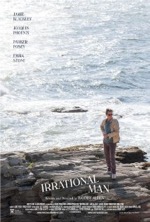
Starring: Joaquin Phoenix
July 2015
This review was originally tweeted in Real-time from the back row of a movie theater and appears @BackRoweReviews. Though efforts were made to tease rather than ruin this movie’s memorable lines and moments, some spoilers may exist in the following evaluation. The original tweets appear in black, while follow-up comments appear in red. For concerns over objectionable content, please first refer to one of the many parental movie guide websites. All ratings are based on a four star system. Happy reading!

“A reputation proceeded me.”
An emphasis on the word “A.” Which infers a negative reputation. Ironically, it’s a negative reputation that Abe is fully aware of. Correction: Preceded. All proceeds from this review will go toward my grammar lessons.
The difference between philosophy and the real world. The #AnneFrank example is thought-provoking.
The point being that always telling the truth can have dire consequences in certain instances. Reference Jim Carrey in Liar, Liar (1997).
Abe avers that much of philosophy is #VerbalMasturbation.
Which is having sex with someone you love. Reference Annie Hall (1977).
Abe has lost “the will to breathe.” He needs to be #Unblocked.
Parker Posey helps Abe out with his whole “blocked” issue. Abe doesn’t need to resort to self love in this instance. I know, TMI.
Abe’s lesson in “existentialism” is shocking. #RussianRoulette
Abe definitely lives on the edge. The extents that he’ll go to in order to prove his point, however, are unhealthy…and dangerous.
Abe finds a new purpose as hit man. #StrangersInADiner
In a way, Jill creates a monster by drawing Abe’s attention to the conversation taking place in the booth behind her in the diner. Reference Hitchcock’s Strangers on a Train (1951).
“Go with your gut.” Abe should know. #BeerBelly
Phoenix really let himself go for this role. Suffering for his art…while eating a Big Mac.
How to lace a fresh squeezed orange juice with cyanide.
It looks a lot easier than it is. Don’t try this at home.
Abe has learned to celebrate life instead of romanticizing death.
Ironically, this new clarity in life comes from murdering someone he’s never met—celebrating death.
The deconstruction of the judge’s murder over dinner is a fabulous scene.
Ethan Phillips (Star Trek: Voyager) stands out here, but it’s his screen daughter, Stone, who steals the scene with her leaps of logic that prove to be dead on.
“A dark cloud had covered the moon.” #SeedOfDoubt
Note to men everywhere: when a woman says there’s nothing wrong, there always is…and there’s a good chance it’s something you said or did.
Abe’s “meaningful act” comes to light.
Abe’s rationalization for his action is disturbing, yet wholly justified from a purely pragmatic standpoint.
Saved by a flashlight.
It was a whistle in Titanic (1997). It’s the little things in life…
Final analysis: The story morphs from a character study to a murder mystery, but is compelling throughout.
I applaud Allen for taking a chance on this ambitious, off format story. This is certainly a unique entry into his oeuvre.
Rating: 3 out of 4. Top notch acting by Phoenix and Stone and sure-handed direction from Allen, as usual.
Woody Allen’s 51st film is a good one, but not a great one. The stars, Joaquin Phoenix and Emma Stone, are fabulous as mentally troubled teacher and starry-eyed student, respectively. The movie is a fascinating character study of Abe (Phoenix), a freethinking, womanizing, liquor guzzling philosophy professor whose melancholia and mania (self Russian Roulette) have established a reputation that’s followed him from his former college to his new one. The shrouded details of Abe’s checkered past create a mystique that proves irresistible to impressionable ingénues and carousing cougars alike. Abe’s projection of redeemable misanthrope acts like a potent aphrodisiac on the colleagues (Parker Posey) and students (Stone) who are helplessly and haplessly trapped in orbit around him. Abe is an intriguing personality for many reasons, not the least of which is that his own personal philosophy of life, and more importantly death, is so disparate from what he teaches in the classroom. Abe’s blind spot is his misguided notion of justice. Jill’s (Stone) blind spot is Abe. Jill follows Abe around like a lost puppy dog and is high on his crafty speech and encyclopedic knowledge, both of which make him sound like he’s figured out all of life’s intricate mysteries. Jill is oblivious to Abe’s dark side for the first half of the movie but her denial gradually wears off when she hears some disturbing rumors which open her eyes to Abe’s true nature…a deeply disturbed, ice-in-the-veins killer. As such, Abe’s psychotic tendencies run antithetical to the archetypal Allen lead character (even with as messed up as Cate Blanchett’s bi-polar busybody was in Blue Jasmine, her character was sympathetic in spite of her mental condition). Abe is sympathetic at the beginning of the film but is wholly irredeemable by the end. This lack of a true-blue hero is one of the story’s biggest drawbacks. The real Achilles’ heel here, though, is the story. By switching thematic gears—from a straightforward character drama to a murder mystery/thriller—midway through the film, Allen runs the risk of confusing or exasperating his audience. However, despite its noticeable narrative modulation, the mid-movie plot shift is a unique story method and Allen’s sure-handed direction makes the transition a relatively seamless one. Irrational is one of Allen’s headier scripts; it’s heavy on philosophy and ethics but light on the signature brand of humor that marks most of his films. All things considered, this is a nice change-of-pace film for the auteur. Sadly, though it contains rich performances and a thought-provoking moral, this film fails to register as top tier Allen. If you disagree with my assessment of the movie, know that I’m doing my best to not resemble the title.
A Walk Among the Tombstones (R)
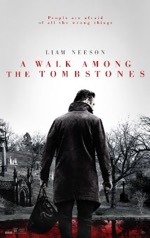
Starring: Liam Neeson
September 2014
This review was originally tweeted in Real-time from the back row of a movie theater and appears @BackRoweReviews. Though efforts were made to tease rather than ruin this movie’s memorable lines and moments, some spoilers may exist in the following evaluation. The original tweets appear in black, while follow-up comments appear in red. For concerns over objectionable content, please first refer to one of the many parental movie guide websites. All ratings are based on a four star system. Happy reading!

Not quite, since this movie is significantly darker than the Taken films and since it involves absolutely no abductions.
Two shots before a shootout.
Drinking and driving is bad enough, but shooting while sauced seldom ends well.
Neeson turns down a job and gets his eight year chip.
A win/win. However, if things ended right here, we’d have a pretty short movie.
An elaborate back story for Neeson’s new case. I smell a setup.
The man who hires Neeson is played by Dan Stevens from Downton Abbey. Another DA star, Michelle Dockery, appeared with Neeson earlier this year in Non-Stop.
Neeson takes the titular walk. Meets the creepy groundskeeper.
Played by Olafur Darri Olafsson (of course it wasn’t fun to type). He looks like the destitute, mentally challenged child of Kevin Page, Bum from Dallas (2012).
Neeson tails a POI and is tailed.
No East Village Plumbing. No surprise.
The punch through the glass is awesome.
One of the coolest scenes in the movie.
The 12 steps narrated over the firefight makes for a unique sequence.
There’s definitely some art here, especially the sobering voice over and freeze frame techniques.
Final analysis: a deliberately paced thriller with an understated but effective turn by Neeson.
Rating: 2 1/2 out of 4. A tale of redemption that’s worthwhile if only for Neeson’s performance.
The most compelling screen heroes have always been the ones beset by some kind of mental or physical flaw…the more severe or debilitating the flaw is, the greater the exultation is at the end of the movie when the protagonist overcomes his limitations, defeats the villain and saves the day. Here, Liam Neeson’s former cop/present private detective is a recovering alcoholic—his problem affected his on-the-job performance which led to his swift departure from the force. The pivotal incident in Neeson’s past serves as opening prologue and intermittent back story, delivered in a series of stylized flashbacks, and is the movie’s spine, or, more appropriately, its heart. Unfortunately, the rest of the movie is standard B-grade thriller fare. The case Neeson accepts is similar (though, admittedly, more graphic) to the plethora of conventional crime plots featured on the ubiquitous network TV procedurals. Other than the movie’s star, the rest of the performers, though well-suited to their roles in most cases, fail to exhibit big screen chops. This should come as no surprise since many of the supporting players here have spent a significant portion of their careers making a name for themselves on the small screen: Dan Stevens (Downton Abbey) and David Harbour (Manhattan) to name just a couple. One aspect of the film that works particularly well is the soiled and seedy NYC locations that serve as immersive backdrop and locus of action throughout the film…the foreboding cemetery, panoramic rooftop, well-appointed or ramshackle residences and even the sparsely populated municipal library are all used to great effect in making this modestly budgeted film seem a bit more prestigious. Credit director Scott Frank with adding visual variety and visceral verve to the handful of action sequences, particularly the poetic, climactic shootout (see above). All things considered, Tombstones isn’t a stellar thriller, but it’s unique in its own right and has much to recommend it. At the very least, this film should tide us over until Tak3n.
Gone Girl (R)
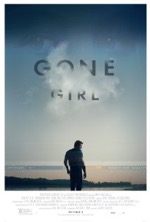
Starring: Ben Affleck
October 2014
This review was originally tweeted in Real-time from the back row of a movie theater and appears @BackRoweReviews. Though efforts were made to tease rather than ruin this movie’s memorable lines and moments, some spoilers may exist in the following evaluation. The original tweets appear in black, while follow-up comments appear in red. For concerns over objectionable content, please first refer to one of the many parental movie guide websites. All ratings are based on a four star system. Happy reading!

Primal questions. Yikes!
If this is really the description of a quotidian relationship, is there any wonder why 50% of all marriages end in divorce?
Villainous chin. First warning sign?
But what exactly constitutes a villainous chin? Long and pointed like Vincent Price’s? Rugged and rounded like Ray Liotta’s? Not sure Affleck’s chin qualifies as villainous by any standard.
A sugar storm and the first kiss.
This is a nice moment, but it’s robbed of any joy or elation since we’re already aware of the relationship’s trajectory.
Who let the cat out?
Ooo…ooo, ooo, ooo!
“We have our first clue.” Ha!
This is a much needed bit of levity to break up the tension. Also, the envelope clues us into the antagonist’s superior confidence in self and utter lack of respect for the abilities and intelligence of the detectives investigating the missing person’s case.
Www.findamazingamy.com. Is this a press conference or marketing blitz?
When you really stop to think about it, the true villains in the movie are Amy’s parents since they’ve gotten rich off of turning their daughter’s image and identity into a brand.
“Everything else is just background noise” works for a season...a short one.
You can only ride the waves of good intentions for so long in a relationship before the swelling emotional tsunami comes crashing down and takes you under.
Ambush at the vigil.
“Does Missouri have the death penalty?” Chilling.
Affleck’s character is a really poor chess player in the movie…he’s consistently two moves behind the person who’s framing him.
Gummy bear toss. Creating a sympathetic public image.
Make it gummy worms and I’ll commit all kinds of mistakes on purpose.
A convenient end note, but enough evidence to convict?
Miracle on the Mississippi...nice spin.
As the legal gun-for-hire, who’s amused rather than distressed by the case’s unexpected turns, Tyler Perry is exceptional in his supporting role.
Final analysis: an incisively smart & subversive missing person mystery with more twists than a roller coaster.
Affleck is convincing, but Pike is creepy good in a role that will have people talking for quite some time.
A lot of hubbub has been made about Affleck’s acting here, and while his performance is solid, it pales in comparison to Pike’s mesmerizing turn as a cold, calculating wife armed with a master plan for how to destroy her husband.
Rating: 3 1/2 out of 4 stars. Fincher’s direction is superb and the screenplay was written by Flynn herself.
There was never any doubt that the writing for Gone Girl would be top notch since the source material was adapted by its author, Gillian Flynn. Enlisting David Fincher (The Social Network) to direct was a canny choice as was tapping top talent in Ben Affleck and Rosamund Pike for the movie’s two central roles. Having all of the right ingredients doesn’t always translate into a successful movie (Waterworld) but, fortunately, the law of averages worked out in this film’s favor. The story of a philandering husband being accused of killing his wife has been done countless times throughout the history of cinema, but this movie’s unique set of circumstances and frequent red herrings, left turns or U-turns keeps the audience engaged right up until the bitter end; a resolution that’s created a great deal of controversy, especially for the scores of people who’ve read the book (I, unfortunately, cannot be counted among their ranks since I chose to read The Maze Runner instead—a grievous choice). Even though the story is methodical and procedural, we never lose interest thanks to Flynn’s diligently measured dialog and finely chiseled characters; all of which are well-rounded and many of which possess modulating or murky or motivations. As a deconstruction of the modern marriage, the film has plenty to say about the problems and pressures contemporary couples face. The scheming, controlling woman paired with a weak willed, low ambition, highly emasculated man is certainly telling of a societal trend that’s been steadily, if not exponentially, escalating since the Mr. Mom 80s. As such, is the movie making commentary on how traditional relational roles have shifted, or reversed, or is it merely spotlighting an isolated—though extreme—incidence of marital dissolution? There’s plenty to process here, which is to be expected since the movie’s superlative script comes from a truly fine novel writer. So, is this film the Fatal Attraction (1987) of our generation, or just a really well told mystery/thriller centered on a troubled marriage? Let the debate begin. But if things start getting heated I’ll be going, going…
The Maze Runner (PG-13)
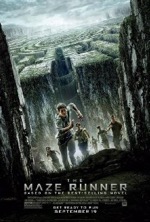
Starring: Dylan O’Brien
September 2014
This review was originally tweeted in Real-time from the back row of a movie theater and appears @BackRoweReviews. Though efforts were made to tease rather than ruin this movie’s memorable lines and moments, some spoilers may exist in the following evaluation. The original tweets appear in black, while follow-up comments appear in red. For concerns over objectionable content, please first refer to one of the many parental movie guide websites. All ratings are based on a four star system. Happy reading!

Not sure I’d want to be part of a world where amnesia is normal.
Although, selective amnesia would be useful for forgetting the less desirable parts of the past.
The box, the tour and three rules.
And a creeper that lurks in the forest.
Ben is banished for breaking the second rule.
Beware the Second Rule! And shouldn’t Thomas start to turn once he’s been bitten by Ben? Oh wait, this isn’t The Walking Dead.
Thomas remembers his name and carves it into the wall.
Seeing all of the scratched out names is a bit unsettling.
Griever descends on Thomas like Shelob.
However, the scene where the giant spider hovers above Frodo in The Lord of the Rings: The Return of the King is far superior to this perspective shot.
A new Greenie arrives with an ominous note.
Markings on supplies: W.C.K.D. Wicked?
Can they make it any more obvious? And what a dumb acronym.
Monolithic walls are quite imposing.
One of the lines from the book perfectly captures the ominous dimensionality of the walls: “Twilight had fallen, and the mammoth walls looked like enormous tombstones in a weed-infested cemetery for giants.” (Chapter 17, third sentence).
Sprinting through the blades...a pulse-pounding sequence.
This is the latest in a long line of genre films where an action sequence was storyboarded as if it were a video game (perhaps with an eye toward being released as a video game). Additionally, the various sections of the maze are like the different levels of a video game.
This just became a horror movie: Night of the Grievers.
And why leave the doors open since the Grievers can climb over the walls and sneak in surreptitiously? I suppose things have to be spelled out for the audience, but wouldn’t it have been even more terrifying if the Grievers had attacked with the doors closed? Oh my God…Grievers! How did they get in?
Griever heads look like cave trolls.
Another LOTR rip-off.
Exit sign. If it looks too good to be true...
Final analysis: a suspenseful mystery that’s fairly faithful to the book with some effective alterations.
Rating: 2 1/2 out 4 stars. Let’s see what this Phase 2 is all about in the sequel.
It’s been brewing for some time now, what with the myriad similarly themed stories that have over-saturated the market in recent years, but it looks as if this movie has finally ushered in a period of dystopian teen novel fatigue...one can only hope. Coming hot on the heels of The Hunger Games and Divergent, this movie is yet another near-future survival tale that focuses on teenagers in perpetual peril. Unfortunately, the source material here doesn’t have anywhere near the socio-political relevance boasted by those other two, far superior book-to-movie franchises. The story begins with a young man named Thomas arriving at a walled in glade via a metal cargo box. Thomas is immediately greeted by a group of boys his own age and soon enough we’re launched into a Lord of the Flies meets Lost meets Labyrinth adventure yarn with heavy quotations of The Lord of the Rings and Jurassic Park. What works here is the initial mystery which places Thomas in this strange environment with no memory of what his life was like before his arrival. The strange speech, customs and rules of the realm also intrigue in the early stages of the story, but made-up words like shank and klunk soon grow tired. Likewise, constantly being reminded of the rules becomes tedious and annoying. The middle of the movie maintains interest with several frenetic chase scenes and major plot revelations. If there’s one area of the movie that grossly underperforms, it’s the standard, unimaginative, and highly improbable ending. SPOILER ALERT: So the whole plot boils down to the fact that the earth has been ravaged by solar flares and the remnant of humanity lives in a gigantic circular city with the maze inhabiting its center. So then, with limited resources, man power, etc, the maze was erected for the sole purpose of providing a training ground for these kids to run around in? This stretch of credulity reminds me of the original Star Trek episode “The Mark of Gideon,” where the Enterprise visits a planet with overpopulation problems. The inhabitants of the world build an exact duplicate of the Enterprise to lure Capt. Kirk down to the surface. Since the populace is shown living in shoulder to shoulder confinement, isn’t the presence of a 289 meter long starship an illogical misappropriation of space on their overcrowded planet? Though not quite as ridiculous, isn’t building massive, movable walls for an extensive series of mazes an egregious waste of time and money for a species on the brink of extinction (and does humanity really have three years to waste on this pubescent experiment)? And why don’t the Gladers know where the edge of the maze is if they’ve constructed a completed, circular mini-maze in the map room (and how can the model be accurate if the walls change every night)? And why is it that on his first foray into the maze, Thomas discovers a section of the maze that the lead runner has never seen on his daily ventures into the labyrinth? When you actually stop to think about it, the movie’s overarching premise is absolutely ludicrous and many of the crucial plot points are utterly laughable…just like the ones in that bottom barrel Trek episode. The intriguing setup desiccates to dust once the teens reach the control center and the less-than-original, far-from-inspired explanation for the whole mystery is revealed. Also, the project leader’s (Patricia Clarkson) staged death is unnecessary and contrived beyond belief. The teenage boys have a graduation of sorts when they find their way out of the maze, which they quickly leave behind when journeying toward their next challenge—an abandoned city where they’ll doubtlessly run into a division of Dauntless operatives itching for a fight in the sequel. So what’s the movie’s takeaway? Some mysteries are better left unsolved. Or, everything was going just fine before that shuck-face Thomas showed up.
Transcendence (PG-13)
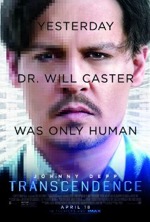
Starring: Johnny Depp
April 2014
This review was originally tweeted in Real-time from the back row of a movie theater and appears @BackRoweReviews. Though efforts were made to tease rather than ruin this movie’s memorable lines and moments, some spoilers may exist in the following evaluation. The original tweets appear in black, while follow-up comments appear in red. For concerns over objectionable content, please first refer to one of the many parental movie guide websites. All ratings are based on a four star system. Happy reading!

It sounded good at the time.
Bettany in a bleak Berkley. Narration decries the downside of technology.
Meaning its ability to take control of our society. Have we learned nothing from Skynet?
Castor wants to create his own god. Hmm... Something tells me that won’t end well.
His comment that all of science is the attempt at becoming God is revealing and somewhat ironic when considering what’s to come for his character in the movie. With statements like that is there any wonder why there’s such a huge rift between religion and science? Correction: Caster.
PINN is the new KIT, but with a lot more computational power.
And not housed inside a car. Minor detail. Correction: KITT.
Now those closest of Castor play God by trying to save his life.
And nobody, not even his wife, thinks this is a bad idea? This is what happens when people stop reading science fiction. Or reading period.
Depp looks creepy in electrode curlers.
But still not as creepy as his chalk complexioned character in Charlie and the Chocolate Factory (2005).
Why does Kate Mara always play a nut job?
Remember her turn as a psycho B on 24?
Castor tells his wife they need to get off the grid. Uh...he is the grid.
Ominous note: Run from this place.
Evelyn still doesn’t take Tagger’s hint. Maybe if he’d written, “Run for you life,” his message would’ve gotten across more clearly.
These guys heal quicker than Wolverine.
Nano rain. Now we’re drifting too close to #Revolution.
This sequence boasts some of the best FX in the movie.
Creepy townsfolk reminds me of Invasion of the Body Snatchers.
They’re really just zombies that look like normal people, which is exactly how zombies looked in 50s movies like the one listed above.
Final analysis: a standard cautionary tale of technology running amok.
Offers some food for thought, but it’s more like a light snack.
Rating: 2 out of 4 stars. Squanders its fine cast with farcical fare. Can you prove you’re self aware?
This movie is a profound disappointment. Longtime cinematographer for Christopher Nolan and first time director, Wally Pfister, drew the short straw on this project. Pfister frames a few nice shots in the movie (especially the rows of solar panels), but the movie’s ordinary, rundown and non-cinematic locales lend the whole proceedings a low budget look. The leaden script from Jack Paglen had no chance of becoming the edgy, poignant, mind trip the movie aspires to be…Inception it’s not. Besides being derivative of many other sci-fi works, The Terminator and ST:TNG’s “The Schizoid Man” among many possible choices, the story is so outlandish that suspending one’s disbelief still doesn’t help relegate it to the realm of reason…or reality. Depp’s performance is muted and uninspired: his slump continues and this just might prove to be his least successful movie ever. Morgan Freeman does the most he can with a cardboard character and Paul Bettany plays a scientist whose shifting motivations are contrived and disingenuous. Rebecca Hall, who turns in the movie’s most sincere and convincing performance, can’t quite sell us on her motivation behind preserving the essence of her husband. This story embodies the age-old axiom of absolute power corrupting absolutely but adds nothing new to the hackneyed formula. The movie flirts with having a message, but the execution of the anemic story line prevents any such notions from gaining traction. What’s unfortunate is that the story actually had the kernel of a compelling idea. Unfortunately, that kernel never turned into something white, fluffy and delicious. Instead, it resides at the bottom of your popcorn bucket with all the other old maids.
Non-Stop (PG-13)
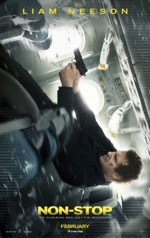
Starring: Liam Neeson
February 2014
This review was originally tweeted in Real-time from the back row of a movie theater and appears @BackRoweReviews. Though efforts were made to tease rather than ruin this movie’s memorable lines and moments, some spoilers may exist in the following evaluation. The original tweets appear in black, while follow-up comments appear in red. For concerns over objectionable content, please first refer to one of the many parental movie guide websites. All ratings are based on a four star system. Happy reading!

Two vices in as many minutes.
Yay, Michelle Dockery from Downton Abbey.
Hugh Bonneville recently appeared in The Monuments Men and Jessica Brown Findlay was the object of Colin Farrell’s affections in Winter’s Tale. It’s nice to see some of the fine Abbey cast members getting some exposure in American films.
Neeson squeezes his “good luck” ribbon.
Anson Mount from #AMC’s #HellOnWheels. Barely noticed him at first.
Clean cut, clean shaven and not a speck of dirt to be seen—quite a transformation.
Mile high melee.
It’s a whole other kind of club.
Fractured text messages and a fractured mirror.
One year free international travel. Ginsu knives included.
What makes the scene so funny, besides Neeson’s earnest delivery, is that some people would actually fall for his bluff.
“Control is an illusion.” How true.
We learned that on 9-11. Consider this movie yet another echo of that fateful day, since it also invokes terrorists hijacking an airplane.
“You should’ve just handed out pamphlets.” Ha!
Final analysis: a decent who-dunnit that’s fairly predictable all the way through.
Correction: whodunit.
Rating: 2 1/2 out of 4 stars. About as entertaining as the similarly themed Flight Plan with Jodie Foster.
It wasn’t that long ago, back when he was the leading man in Schindler’s List (1993), Rob Roy (1995) and Michael Collins (1996), that Liam Neeson was considered a top shelf dramatic actor. Then his career took a sharp left turn when he played Jedi Master Qui-Gon Jinn in Star Wars: Episode I—The Phantom Menace (1999). Now, Neeson has become firmly ensconced in a new phase of his career with B tier thrillers such as Taken (2008), Unknown (2011), Taken 2 (2012) and now this film. One can’t help but wonder if Neeson’s considerable acting talents are being wasted on such middlebrow projects. Still, I’m sure the paychecks are nothing to squawk about and Neeson certainly has commercial viability—despite the fact that he’s an aging action star. But hey, if Sly and Schwarz can do it... There isn’t anything special to the plot and the high altitude thriller concept has been done enough at this point that what the writers consider to be ingenious twists are merely egregious contrivances. Still, the movie isn’t without merit or entertainment value, especially when Neeson asserts his authority and beats up bad guys—the zero G shootout is one of the movie’s standout scenes. Worth a watch if you’re in the mood for a remedial thriller. Final thought: I wonder how many airlines will include this film as part of their in-flight entertainment package. There are a lot of idiots out there and you just don’t want to give them any ideas.
Jack Ryan (PG-13)

Starring: Chris Pine
January 2014
This review was originally tweeted in Real-time from the back row of a movie theater and appears @BackRoweReviews. Though efforts were made to tease rather than ruin this movie’s memorable lines and moments, some spoilers may exist in the following evaluation. The original tweets appear in black, while follow-up comments appear in red. For concerns over objectionable content, please first refer to one of the many parental movie guide websites. All ratings are based on a four star system. Happy reading!

Flying in helicopters can be such a backbreaker.
What do you do when you need security from the security?
Better have some fighting skills, I suppose. Fortunately, Ryan is covered in that department.
Pine tells Costner his very scary scenario.
What kind of a man steals a dog?
What’s more, a dog belonging to a family living in a foreign country?
“This is geopolitics not couples therapy.” Great line.
Big splash scene is spectacular.
But seems somewhat hackneyed as a climactic event.
Final analysis: a good action/spy flick but not nearly as pulse-pounding as the Bourne films.
Rating: 2 1/2 out of 4 stars. Clancy would be proud of this effort. Will the Shadow Recruit return?
This Jack Ryan movie is the first in the series that isn’t based upon a novel written by the late Tom Clancy. I think Clancy would be proud that the character he created is still thriving on the big screen, and, what’s more, getting a youthful overhaul. However, I’m not sure he would be as sanguine about a story that’s sub-standard to the intricate, multi-layered work the author churned out consistently throughout his career. Pine is an effective choice for Ryan and the supporting cast of Costner, Knightley and Branagh are each well suited for their roles. Bottom line here is that the movie’s action sequences and overall narrative effectiveness fail to measure up to Clancy’s criteria. My suggestion is to return the series to the source material that made Jack Ryan a compelling character to begin with…Clancy’s novels.
Escape Plan (R)

Starring: Sylvester Stallone
October 2013
This review was originally tweeted in Real-time from the back row of a movie theater and appears @BackRoweReviews. Though efforts were made to tease rather than ruin this movie’s memorable lines and moments, some spoilers may exist in the following evaluation. The original tweets appear in black, while follow-up comments appear in red. For concerns over objectionable content, please first refer to one of the many parental movie guide websites. All ratings are based on a four star system. Happy reading!

Don’t know why, but I always spell his name wrong…should read Sly and Schwarz. With many apologies to the former Governator, who will undoubtedly hunt me down and make me pay for such a transgression.
Sly’s deconstruction of his breakout. Nifty sequence.
But is it too much like a magician revealing how he did a trick?
Chip is extracted...Houdini is on his own.
M.C. Escher must’ve designed this prison.
Sly meets the “favor man.”
A macho meet-cute.
“You hit like a vegetarian.” Ha!
A new challenge for the breakout artist. A cover story created.
The prison doctor has a familiar bearing. I think he was an archaeologist in a former life.
Lots of wipes now to speed the story along.
Very smart since there isn’t much story here to begin with.
Plan B. How long can you hold your breath?
Final analysis: far better than I thought it was going to be. Still a bit B tier, but entertaining.
Rating: 2 1/2 out of 4 stars. A headier brand of action movie which suits the aging stars. A decent flick.
I have to admit, this movie was far better than I thought it was going to be. A movie headlined by two aging 80s action stars is an amusing stunt from a marketing perspective, but from the vantage of a ticket-buying spectator, the film seemed less than promising. Surprisingly, the serviceable story maintains interest throughout and the actors aren’t as wooden as would be expected. Though Sly walks around with a perpetual stinger in his neck and Schwarz doesn’t look half the man he used to be, both actors have fun with their parts and it’s that good-natured ribbing between the two “manly man” leads that carries the film—their chemistry is undeniable and such synergy propels the movie through improbable plot twists to its harrowing climax. All in all, this is a satisfying popcorn action picture that will tide you over until the next Expendables movie.
Closed Circuit (R)

Starring: Eric Bana
August 2013
This review was originally tweeted in Real-time from the back row of a movie theater and appears @BackRoweReviews. Though efforts were made to tease rather than ruin this movie’s memorable lines and moments, some spoilers may exist in the following evaluation. The original tweets appear in black, while follow-up comments appear in red. For concerns over objectionable content, please first refer to one of the many parental movie guide websites. All ratings are based on a four star system. Happy reading!

Steven Knight.
Multi-camera opening reminds me of a Person of Interest episode.
“Fair and transparent.” Broadbent certainly isn’t referring to the US justice system.
Judge lays out the rules for the case...the relational ticking time bomb is set.
42191. The mystery deepens.
Cross-cutting between both sides of the investigation keeps the plot rolling along.
Broadbent warns Bana not to stray. A taut exchange.
The plot reveals its hand at this point though…Knight should’ve worked a little harder to shroud the purpose and function of this antagonist.
“Thou shalt not communicate” commandment is broken. Ramifications could be far-reaching.
Howe grills Witness X. Wow!
Hell hath no fury…and boy does she unleash it.
New plan...get him to the court on time.
They skip the whopper of a topper though.
Breakfast with Broadbent. “Let it go.”
Also Henry’s advice to his son in Indiana Jones and the Last Crusade (1989).
Final analysis: a decent spy yarn infused with the appropriate degree of paranoia.
Features fine performances all around and boasts deft direction.
By John Crowley.
Rating: 2 1/2 out of 4 stars. Non-thrilling Thriller sputters down the runway but never quite takes off.
The abilities of some truly fine actors were squandered here. The story isn’t very gripping from the outset and never really goes anywhere…well, nowhere exciting anyway. Cut from the same narrative cloth as Tinker Tailor Soldier Spy (2011), this film is a slow boil political yarn that fails to deliver the major climax we anticipate. And how many times must Bana be told to back off the case before he gets it…or gets it? Long after the audience is bored to tears, I suspect.
Now You See Me (PG-13)
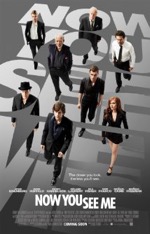
Starring: Jesse Eisenberg
May 2013
This review was originally tweeted in Real-time from the back row of a movie theater and appears @BackRoweReviews. Though efforts were made to tease rather than ruin this movie’s memorable lines and moments, some spoilers may exist in the following evaluation. The original tweets appear in black, while follow-up comments appear in red. For concerns over objectionable content, please first refer to one of the many parental movie guide websites. All ratings are based on a four star system. Happy reading!

Receiving tarot cards from a hooded mystery man is never a good thing.
I thought teleportation was only possible in Star Trek.
First rule of magic. Don’t drink Diet Pepsi with something that rattles inside.
Also the first rule of common sense.
Great to see Michael Caine and Morgan Freeman together again.
Unbelievably, for the first time ever in a scene together. Although, both men appeared in Nolan’s Batman trilogy, their characters never crossed paths.
Rob the rich and give to the poor. Robin Hood would be proud.
Ruffalo tracks himself. Maybe he’ll find a better personality.
Unless you’re Gambit, thrown cards can’t do much damage.
Is the high speed chase just another misdirection?
Or just a stunt to infuse more action into the movie?
Awesome holographic projections at Five Points.
Resolution: Love trumps magic.
If it sounds oversimplified…it is.
Final analysis: Too slick for its own good. The trick was on me for shelling out a ten spot on this movie.
Harrelson and Eisenberg were phenomenal in Zombieland, but so-so here.
Rating: 2 out of 4 stars for shallow character development and a plot that was merely a house of cards.
The movie had some decent moments and solid acting from its diverse and decorated cast, but it failed to deliver the sensational “ah-ha!” it promised from the outset. If you’re looking for a better magic movie check out The Illusionist (2006) and if you want a hipper heist flick Ocean’s Eleven (2001) should be your ticket.
Prometheus (R)

Starring: Noomi Rapace
June 2012
The opening sequence of Ridley Scott’s highly anticipated Alien prequel, Prometheus, is, perhaps, the most startlingly original teaser in the history of sci-fi films. An albino humanoid stands near a mountain stream, drinks some strange viscous concoction and begins retching. The sequence simultaneously begs a host of questions. Who is this strange-looking alien? Where does he come from? Is he on Earth of the distant past or future or some planet that looks just like the Scottish Highlands? And just what exactly is that disgusting grog the guy drinks (bad Romulan Ale)?
These questions are just the tip of the proverbial iceberg in an intentionally murky movie that will probably leave many audience members feeling lost. It seems fitting, then, that one of the film’s script writers is Damon Lindelof, co-creator of TVs critically acclaimed Lost, which was also a mythology heavy, mind-bending slice of top shelf sci-fi. Ironically, Prometheus’ opening sequence is a microcosm of the entire film: beautifully crafted and filmed, yet frustratingly cryptic.
By now, the Alien universe has been so well established (themes, iconography, etc.) that innovation is hard to come by. Many of the film’s new elements work just fine, but old patterns are hard to break and creep in as if on cue. Case in point, no Alien movie would be complete without a decapitated android and here that bill is filled by Michael Fassbender’s eerily serene David, who pops his top late in the film. A narrative mainstay in many Alien films is the lead female being impregnated by an alien; in this instance the hapless heroine is Noomi Rapace’s Elizabeth Shaw. Here, Shaw uses laser scalpels and other hi-tech medical instruments to abort the alien fetus from her own distended belly…easily the most creep-tastic sequence in the film, doubly so for men I’ll wager.
Another cliché: dumb characters don’t stand a chance when the bloodletting begins. Not only are these engineers more doltish than the typical scientists, they can’t regulate the impulse to touch items that can potentially destroy them once inside the alien structure—even when the impending danger is clearly pointed out to them they’re still powerless to resist handling foreign objects. I guess scientists and engineers will always be kids in a candy store whenever alien artifacts and technology are present.
When it becomes obvious after the initial round of introductions which person will be the first victim you know your story is a tad too predictable, and Prometheus certainly doesn’t break that mold. Sad thing is, we really don’t care when these ancillary characters die because, as with Star Trek’s “redshirts,” we don’t know the first thing about them…they’re disposable to us and the story. If there hasn’t been any investment in character development, why should we care if they die? We don’t, and that’s the point.
If there’s one area of the narrative that invites scathing criticism it’s the frequent trips to the alien fortress. After loosing all of their engineers on their first foray, what would induce the remaining characters to go back for a repeat visit? Curiosity? Stupidity? Pressure from the filmmaker who only has half a film at this point and needs a higher body count to earn an R rating? But they do go back, again and again...like lambs to the slaughter. And people keep dying. At some point you’d think the characters would figure out that the alien haystack isn’t the Matterhorn ride at Disneyland.
Worse than the frequent trips to the alien slaughterhouse is that we’re taken along for the ride each time and always from a low angle perspective of the tire rim or a helicopter shot of the motorcade approaching the alien structure. These exterior shots leave us feeling cold, effectively on the outside looking in. Why didn’t Scott utilize these segues to give us some good-natured banter among characters or little glimpses into the back stories of these individuals, a la the Humvee scene early in Iron Man (2008)? As is, these ping-pong ventures between the ship and alien fortress are squandered opportunities to shore up one of the film’s most sorely lacking commodities—character development.
Although the climactic ship collision/crash is visually spectacular, the resulting nonsense of characters trying to get out of its path could’ve been trimmed from the film with little consequence. It’s one thing if you’re Indiana Jones trying to outrun a steamrolling ball of death down a narrow tunnel, but it’s something entirely different if a ship is falling in your direction and you’re in the middle of an expansive plain. This type of imperilment is common in movies and I always end up asking myself, do characters not realize they can run to one side or the other to avoid what’s rolling/moving straight toward them? Why must they run in a straight line in an effort to outrun the object of impending danger? It must be plain idiocy and an utter lack of knowledge regarding the laws of physics and gravity that drives these characters’ actions. Even more egregious is the amount of screen time dedicated to this ostensibly thrilling sequence which fails to advance the plot in any significant way. The entire sequence is nothing more than a self-indulgent excuse to employ a massive set piece in order to generate a shallow thrill for the audience, something Michael Bay would normally do, not Ridley Scott.
In the final analysis, Prometheus will only be admired by those who enjoy a hard sci-fi yarn that grapples with the questions of existence, but ultimately fails to answer those questions in the end. Action junkies will be disappointed in the film as will those who’ve come to expect a certain amount of intensity and gore from the franchise. Though Scott’s original Alien (1979) did far more with a lot less, Prometheus is still a handsomely mounted, visually staggering film. As an art film under the guise of a commercial release Prometheus may, well…alienate a large portion of its audience.
Rating: 2 1/2
The Adventures of Tintin (PG)
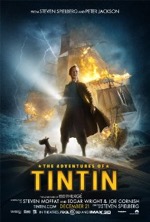
Starring: Jamie Bell
December 2011
Upon discovering a clue inside a model ship in a bottle, young reporter Tintin (Jamie Bell), Captain Haddock (Andy Serkis) and sidekick dog Snowy set out on a globetrotting journey to find a sunken ship named the Unicorn; one of Haddock’s ancestors was skipper of the boat. Of course, the adventurers have no interest in the actual ship…only the treasure contained inside its decomposing hull. As usually happens when treasure is involved, opposing forces are soon drawn to the search and here the villain is nefarious Sakharine (Daniel Craig). The race is on, but which group will be the first to find the Unicorn and lay claim to its bountiful riches?
Based on the series of comic books written and drawn by Belgium artist Herge in the 30s and 40s, The Adventures of Tintin is the new CGI/motion capture extravaganza envisioned and produced by two of cinema’s finest action/adventure directors: Peter Jackson (The Lord of the Rings) and Steven Spielberg (Jurassic Park). In various interviews, both auteurs have expressed their immense affection for the source material. That profound reverence is abundantly evident in the loving detail lavished upon every frame of the film. Adapted from three Tintin stories, The Crab with the Golden Claws (1941), The Secret of the Unicorn (1943) and Red Rackham’s Treasure (1944), The Adventures of Tintin is the perfect marriage of the Pirates of the Caribbean and Indiana Jones franchises.
The opening credits sequence, which features a traditional animation aesthetic with an infectious jazz score by the inestimable John Williams, is an amusing and stylish montage of action vignettes that sets the tone for the film. The snappy opening recalls similar sequences in the Pink Panther movies, Casino Royale (2006) and Catch Me If You Can (2002), which was also scored by Williams.
When the film begins, the cutting-edge alchemy of mocap and startlingly photorealistic CGI backgrounds overwhelms the eyes with its mesmerizing brilliance. Indeed, it takes a moment for the brain to adjust to the fact that what you’re seeing isn’t real but, as Miracle Max from The Princess Bride (1987) would say, only “mostly” real. Or maybe we should use the word partially real to describe how staggeringly real-to-life the mocap images appear in the film, courtesy of Jackson’s team of FX wizards at Weta Digital.
One of the issues Pixar ran into while producing The Incredibles was that the CG humans were so lifelike that test audiences reacted negatively toward the pixilated people. Apparently there’s such a thing as designing CG characters that look too real. Pixar’s solution was to redesign their character templates with less detail while adopting facial features more in step with traditionally hand drawn cartoon characters. Judging from the film’s runaway success, it seems that Pixar made the right call.
That said, if there’s a tolerable range for how realistic CG characters can appear (without producing mental revulsion), Tintin definitely pushes the boundaries with its startlingly photorealistic people, places and things. Though some of the movie’s characters look more cartoony than others, detective duo Thomson (Nick Frost) and Thompson (Simon Pegg) for instance, others, like the eponymous character, are astoundingly realistic in appearance—especially around the eyes. Tintin’s trusty companion, a scrappy dog named Snowy, is rendered in CG but has more of a traditional 2D appearance, with matted fur rather than the poofy pelt boasted by Sully in the Monsters Inc. films.
While the Lord of the Rings trilogy cracked open the door for motion capture performances, Avatar (2009) kicked the door down with its breathtaking blend of mocap and CGI. The mocap employed here is the next iteration of the process and it only seems fitting that Jackson would return to his go-to guy for one of this film’s mocap characters. Having already brought Gollum and King Kong to life, the brilliant Andy Serkis was the perfect (only?) choice to play Captain Haddock. Serkis turns the boozy bearded one into a fully realized character, filled with fears and foibles. It’s doubtful that anyone else could’ve pulled off the character quite the way Serkis does. Jamie Bell, likewise, wholly inhabits the title role and imbues the character with a degree of exuberance and wide-eyed wonder befitting the young adventurer…such emotions are perfectly conveyed by Bell’s facials, body language and movements. Tintin’s unquenchable thirst for knowledge in pursuit of a good story is infections and makes Bell’s captivating performance a joy to watch.
As for the movie’s action, and there’s plenty of it, there can be no doubt as to Spielberg’s involvement with the storyboards as his signature is evident in each frame of the movie’s many action scenes. Few would argue that the makeshift zip-line course in Morocco is the finest action scene in the film. The sequence is an exhilarating series of close shaves and gravity defying stunts which is immersive to the degree that you feel like you’re on a roller coaster ride. Although a completely different setting and scenario, this sequence is reminiscent of the frenetic, high-throttle mining cart pursuit in Indiana Jones and the Temple of Doom (1984). What I like most about the sequence is that it actually allows your eyes to adjust to each movement or course correction, unlike the majority of action films these days which use a blurry handheld camera in capturing chase/fight scenes. Thank you, Mr. Spielberg, for bringing back the sheer visceral elation of a well choreographed, judiciously filmed action sequence.
Tintin is a rollicking, rousing good time with memorable characters, dazzling action sequences, stellar direction and a bracing mystery all rolled into an intensely fun and frenetic action/adventure yarn told with classic Hollywood flair. When Jackson and Spielberg first met to discuss bringing Tintin to the big screen, they agreed to do two movies and that they would each direct one of the films. Looks like it’s Jackson’s turn to step up to the wicket. We’ll see if he brings a darker sensibility to the sequel: Tintin and the Marauders of Mordor.
Rating: 3
Source Code (PG-13)

Starring: Jake Gyllenhaal
April 2011
Too soon on the heels of Inception (2010) or The Adjustment Bureau (2011)? Perhaps, but director Duncan Jones’ (Moon) Source Code is more derivative of TV series than heady, mind-trip flicks.
Exhibit A: Quantum Leap (1989-1993). Scott Bakula’s Sam Beckett leapt into different people (and the occasional space chimp) on a weekly basis to rectify some past wrong. In order to identify what person he was impersonating, all Sam had to do was look in the mirror—a concept that Source Code exploits early in its narrative.
Exhibit B: Seven Days (1998-2001) a lesser known UPN sci-fi series centered on the exploits of Frank Parker (Jonathan LaPaglia), a Navy captain who is sent back in time seven days (in Source Code it’s a breezy eight minutes) before a major catastrophe in order to avert it. Source Code borrows liberally from the premise and trappings behind Seven Days, right down to the military officer as the central character, a dubious space/time apparatus and multiple jumps backwards and forwards through time.
Exhibit C: 24 (2001-2010) Counter-terrorist agent Jack Bauer (Kiefer Sutherland) must thwart terrorist plots designed to cripple or nation in a perpetual race against time. Since Source Code deals with acts of terrorism in metropolitan areas, specifically a bomb on the train, we can also cite 24 as a possible antecedent to Jones’ shifty/trippy yarn.
Jones’ direction is taut, especially his stylistic flourishes to signify time travel and time compressed montages for less significant loops, and the performances are solid across the board (although Gyllenhaal and Monaghan’s foisted romance is a bit saccharine and Jeffrey Wright’s attempts at channeling a techno-babbling scientist are less than stellar). The movie fails to soar due to the myriad contrivances upon which its premise and story are based. Even the concept of learning more clues with each new perspective is reminiscent of Vantage Point (2008), which was heavily influenced by Kurosawa’s Rashomon (1951).
The conceit of a time traveler stuck in a causality loop has been explored ad nauseam in the sci-fi pantheon and, unfortunately, Source Code adds very few new riffs on the formula. The only innovation here is Jones’ opaque coda, which will leave at least half the audience scratching their heads as they exit the theater (I’m pretty sure I get it, but I’m not one hundred percent sure myself). The plot was satisfactorily concluded about fifteen minutes from the end, so why did the movie overstay its welcome? Jones’ parting shot is counterintuitive in that it risks confusing a significant segment of the audience over a mind-bending “ah-ha” denouement that could’ve just as easily been left on the cutting room floor. If you get the film’s conclusion, good for you; if not, join the club.
You’ve seen it all before, but maybe Source Code’s fresh faces and unique assemblage of standard plot devices will keep you entertained. I’ve got to admit that I had high hopes for this one, but in the end, Source Code is largely a waste of time.
Rating: 2 1/2
The Ghost Writer (PG-13)
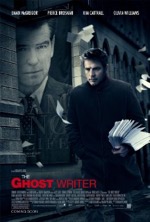
Starring: Ewan McGregor
March 2010
“Polanski’s Political Potboiler Stars a Superspy and a Jedi”
Roman Polanski’s The Ghost Writer, though not as shocking as Chinatown or as haunting as The Pianist, is a fine film in its own right, a taut thriller told from the epicenter of a political earthquake. At the center of the epicenter is Adam Lang (Pierce Brosnan), former Prime Minister of Britain, who’s been accused of advancing American policies while he was in office. The revolving door of ghost writers commissioned to massage Lang’s memoir into printable form soon sweeps a young and ambitious scribe, simply referred to as The Ghost (Ewan McGregor), into the web of intrigue and controversy that seems to surround Lang wherever he goes: Lang ping-pongs back and forth between native England and the eastern seaboard of the US.
We enter Lang’s world as an interloper, a voyeuristic onlooker to the drama that unfolds around Lang and those in his orbit. Lang, though understandably and undeniably aristocratic in public, is much more subdued behind closed doors, especially in one-on-one interviews with The Ghost. Past the officious exterior, Lang, when finally able to lay aside the worries of the world, displays a degree of vulnerability that’s a bit unsettling at first. It’s an expertly measured performance by Brosnan, a career actor with an inestimable range (Lang is a light-year from Bond).
McGregor also turns in a fine performance that’s deceptively understated in its fly-on-the-wall subtlety. Even though Lang is sympathetic and central to the plot, the audience identifies more strongly with The Ghost since he’s brought into the political turmoil at the same time that we are. As The Ghost forms his opinions of Lang, we’re right there peeking over his shoulder, sensing, as he does, that something isn’t quite right in Lang’s world.
The Ghost’s expressions of confusion, suspicion and apprehension are mirrored on our faces: in this way, director and writers see to it that character and audience are on equal footing. Or perhaps Polanski is deluding the audience into a state of false confidence. Perhaps The Ghost is one step ahead of us and the only reason we’re clued in at all is because his writer’s eye is leading our gaze to details we would normally miss. Either way, this narrative choice allows for tangible tension to reign supreme throughout the story…and we can be grateful in our consternation since the movie’s intricate web of intrigue ensures a more satisfying viewing experience than a paint-by-numbers puzzler.
Of course, keeping the audience in the dark and methodically parsing out plot details at a pace which produces maximum suspense is a staple of the thriller genre, and few do modern-day political potboilers better than Polanski. Polanski knows how to gradually build anticipation until…bang, some major character revelation or unforeseen event causes a rupture in the story’s stasis. Even though the action never reaches the fevered pitch of a Bourne movie, there are some nail-biting episodes like when The Ghost takes a trip on a ferry boat and discovers that he’s being shadowed.
Though the film’s intensity ebbs and flows (like the undulating ocean waves visible through the window in Lang’s office), an undercurrent of dread is ubiquitous, like apprehensions over the impending storm. The literal storm that’s been brewing since the movie’s early stages finally hits midway through, just as several character arcs are reaching their breaking points. The storm scene, of course, is symbolic of what the characters are experiencing. What would’ve come across as telegraphed by a lesser director is artistically and organically achieved by Polanski, whose expert grasp of storytelling allows for a slow boil approach to these climactic events.
The movie’s East Coast locales serve as an additional, though non-corporeal, member of the cast. The visual splendor Polanski creates, with the assistance of cinematographer Pawel Edelman, is nearly palpable. The overcast, blustery shoreline scenes along Martha’s Vineyard (surprisingly shot in Germany) are visually immersive and are the perfect accompaniment for the movie’s melancholy mood. The scene where McGregor bikes over to Eli Wallach’s house, the expanse of gray and beige creating a haunting yet beautiful tableau all around him, has more atmosphere than many movies have in their entirety.
One of the film’s many highlights is the showdown interview between The Ghost and Paul Emmett (Tom Wilkinson). Few actors can lace pleasantries with napalm like Wilkinson; his character’s thinly veiled disdain for The Ghost boils just beneath the surface of his composed and professional demeanor. Besides containing some tense, hair-raising dialog, the verbal sparring match between Wilkinson and McGregor sets into motion a chain reaction that ultimately leads to The Ghost’s untimely demise: if you’ve seen any of Polanski’s back catalog you can make an educated guess at the nature of the film’s down ending.
Although The Ghost Writer fails to measure up to Polanski’s earlier masterpieces, it’s still a taut yarn with fine performances and a riveting riddle that will keep the audience guessing right up until the bitter end. And let’s face it, a lesser Polanski film is still better than the vast majority of films Hollywood is turning out these days. There’s little intrigue in that statement.
Rating: 3
National Treasure: Book of Secrets (PG)
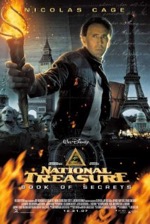
Starring: Nicolas Cage
December 2007
“Gates Works Harder, Gets Richer in Globetrotting Sequel”
The sequel to 2004’s National Treasure is subtitled, Book of Secrets. The titular book is a rumored collection of top-secret articles and accounts for the president’s eyes only. Ben Gates (Nicholas Cage) and his father, Patrick (Jon Voight), follow a series of clues that lead them on a frenetic steeplechase through France, London and Washington, D.C. Once discovered, the book offers additional clues that direct the Gates’ plus sidekicks, Abigail Chase (Diane Kruger) and Riley Poole (Justin Bartha) along with antagonist, Mitch Wilkinson (Ed Harris) to Mt. Rushmore where the discovery of a secret treasure will clear the Gates family name (something about Ben’s great-grandfather allegedly being a co-conspirator in Lincoln’s assassination).
I won’t go into too much detail about the cohesive yet scattershot plot, but I will say that NT2 is every bit as good as the original and perhaps a tad better. NT2 has a broader canvas than the original; besides adding European destinations to the itinerary, the film also introduces some new characters and features a more elaborate treasure hunt.
The finest new addition to the cast is Helen Mirren as Ben’s mother, Prof. Emily Appleton. Patrick and Emily, who were separated a number of years ago, are reunited out of necessity; seeing them thrown back into the mix together is actually the most enjoyable aspect of the film. Ben and Abigail’s relationship has also hit the skids and whereas some of their vehement interactions are amusing, the relational discord just didn’t work for me as well as Ben’s bickering parents. But in light of this nation’s alarming divorce rate (and Hollywood’s even worse track record), it’s refreshing to see couples working out their differences instead of just giving up…a very positive example, especially for the younger, more impressionable, segment of the audience.
As with the first National Treasure, viewers are required to suspend their disbelief to staggering heights and buy into conspiracy theories based on some facts with a ton of supposition and wild leaps of logic to spare. Out of all the head-scratching elements in the film, the one I just couldn’t abide is the scene where Ben abducts the president (Bruce Greenwood)…like it could possibly be that easy. However, all’s well that ends well as the prez. later exonerates Gates of any wrongdoing…I’m sure it had a lot to do with Ben finding the national treasure which will help pay off the national debt.
So, what did Ben see on page forty-seven of the Book of Secrets? If the box office is favorable for NT2, we might only have a couple years to find out. Otherwise, that secret knowledge might end up buried in the past.
Rating: 2 1/2
The Prestige (PG-13)

Starring: Christian Bale
October 2006
“Are You Watching Closely? You’ve Been Tricked!”
Director Christopher Nolan and actors Christian Bale and Michael Caine were driving forces behind last year’s critically acclaimed, comic book-to-big screen action thriller, Batman Begins. Add to that team X-Men’s Wolverine, Hugh Jackman, and the sultry siren, Scarlett Johansson and you have a surefire hit on your hands…right?
As would be expected, the film opens with a magic show. The magician is assisted by Cutter (Caine) backstage and Robert (Jackman) and Alfred (Bale) who are planted in the audience and selected every night as part of the performance. Robert and Alfred are aspiring magicians, but their association as friends and colleagues abruptly ends when Robert’s wife, Julia (Piper Perabo), drowns in a water tank during an illusion gone wrong. Robert casts blame on Alfred, who always tires to push a trick to the next level and takes unnecessary risks. The balance of the movie deals with Robert’s repeated attempts to avenge his wife’s death, while trying to beat Alfred at his own game.
The game of one-upmanship between the two competing magicians is engaging at first, but the point and counterpoint plot exponentially looses steam as the movie progresses. The movie’s climax is like a chess skirmish where both players trade pieces until one player takes a piece and his opponent can’t counter, producing a clear-cut victor. Trying to figure out who will outthink his rival and deal the ultimate deathblow was clearly intended to be an enjoyable experience, but the volleying storyline, in the end, is more exhausting than exhilarating.
These disparaging comments are in no way an indictment against the director, actors or anyone else involved in the movie’s creative or technical departments, all of whom did an exceptional job of transporting the viewer into this turn-of-the-century period piece. If any area of the movie bears criticism, it’s the prefab plot based on Christopher Priest’s novel. Every magic trick is based on diversion and deception, and the storyline here deals in the same kind of chicanery—the plot is a façade that appears to be an intricately woven yarn, but is simply a hollow attempt at generating Industrial-era intrigue; wowing audiences with its all-star cast, the movie only offers cheap thrills and unfulfilled promises.
At the movie’s midpoint, Robert seeks out eccentric inventor, Nikolas Tesla (David Bowie, in a brilliant piece of surprise casting), who builds Robert a machine that is way beyond today’s technology, much less that of a century ago. As egregious as that is, the final nail in the movie’s coffin is protagonist confusion. Just who are we supposed to root for here? True, the magicians demonstrate their genius over the course of the film, but both men are so riddled with foibles, ranging from self-aggrandizement to an overactive need for vengeance, so as to be flawed beyond recognition as heroes. The person I wanted to come out on top suffers ultimate defeat, but who cares? There’s nothing virtuous about either magician and in the end, it doesn’t really matter who you pull for, they’re both egomaniacs who stop a nothing to produce better illusions than their opponent and, therefore, are utterly despicable. Did screenwriters Jonathan and Christopher Nolan fail to realize that the audience would naturally want to choose sides and that every story must include at least one hero that everyone can cheer for?
I so badly wanted this film to succeed, but alas, the movie falls for its own sleight of hand. If, like me, The Prestige left you wanting more, check out the other recent magician movie, The Illusionist, starring Edward Norton. Unlike The Prestige, The Illusionist doesn’t waste its or your time on competitive shenanigans or scientifically impossible illusions…there’s nothing hidden up its sleeve.
Rating: 2 1/2
The Illusionist (PG-13)
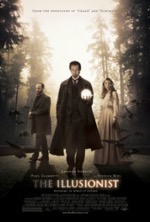
Starring: Edward Norton
September 2006
“Like Lucky Charms, It’s Magically Delicious”
As I started jotting down notes at a screening of The Illusionist, my pen abruptly died. After exhausting every conceivable strategy of coaxing ink out of the depleted stylus, I settled on an alternate note-taking strategy. I wrote my observations with a firm hand and later retrieved them by rubbing pencil lead over the page, which revealed the text in reverse. When I started writing this review, it suddenly occurred to me that such basic science might be commonplace to you and me, but to a five-year old child it might appear as…magic!
The magic performed by Eisenheim the Illusionist (Edward Norton), however, is a tad more sophisticated than my pencil-rubbing trick. It is said that, as a boy, Eisenheim was inspired by a traveling magician who showed the lad a few illusions before disappearing into thin air. Magic consumed the Eisenheim during his formative years, but his focus expanded the day he encountered the beautiful duchess, Sophie. Despite their disparity in social standing, Eisenheim and Sophie were inseparable growing up; “One day we’ll run away together,” she promised.
As an adult, Eisenheim plies his trade as an illusionist in small, but packed theaters in Vienna, garnering the esteem of many prominent patrons, including the inquisitive Chief Inspector Uhl (Paul Giamatti). During that fateful performance, the magician asks for a volunteer, and, much to his surprise, Eisenheim is reunited with his childhood sweetheart when she glides onto the stage. After the show, Eisenheim learns that Sophie (Jessica Biel) will soon be engaged to Leopold (Rufus Sewell), the crown prince. Sensing the potential threat posed by Eisenheim, Leopold orders Uhl to “shut him down” (surely a common phrase during that period). With Uhl watching his every move and Leopold seeking his life, Eisenheim creates a new show that must confound the audience, foil Leopold’s plans and win back Sophie’s heart before it’s too late.
As the movie’s slogan suggests, “Nothing is what it seems.” This is certainly true as the movie never reveals its hand until the very last scene. Based on a short story by Steven Millhauser entitled “Eisenheim the Illusionist,” writer/director Neil Burger does an excellent job of managing this gothic tale, which certainly would have floundered in the hands of someone less visionary. The costuming, makeup and historic props and sets all exude authenticity and Burger’s use of a sepia-hued palette, aged film stock effects and old-fashioned circle wipes is extremely effective. Also, the revelation scene—where Uhl mentally deconstructs Eisenheim’s ultimate illusion in a montage of shots—is a brilliant way to illustrate the Chief Inspector’s flow of deductive reasoning.
Norton (The Italian Job) is a bit subdued here, but plays the part of Eisenheim with deftness equal to the skilled magician. Impressively, Norton did most of his own tricks in the movie (with the assistance of magician David Blaine), and what’s more, very few of the movie’s illusions received a CG touch-up.
Biel and Sewell (A Knight’s Tale) work fine as an improbable couple and their performances, as secondary characters, properly garnish the juicy ménage trios subplot—Biel soars here, leaving behind her 7th Heaven chrysalis. Though all of the actors shine, Giamatti’s performance stands out like a lighthouse beacon on a stormy night. Giamatti’s range is awe-inspiring; I’m thoroughly convinced that if someone put a white, fluffy wig on the actor’s head and said, “Be a Q-Tip,” he would not only pull it off but add unexpected nuance to the part. For The Illusionist, Giamatti adopts a European accent and a resonant baritone; he speaks softly, but with authority. Sporting a full beard and slicked back hair, viewers may fail to recognize Giamatti at first glance. Whereas Norton is the film’s heart and soul, Giamatti is its conscience and backbone…the versatile character actor has turned in yet another memorable performance.
Due to the constraining nature of a period piece featuring a magician, the movie, though entertaining and thought-provoking, is far from Best Picture caliber. However, the movie does boast one of the most satisfying twist endings to come along in quite some time. Anchored by a superior cast, The Illusionist juggles character development with breathtaking cinematography and an intricate plot that contains just the right amount of romance, political intrigue and brow-furrowing mystery. Now that’s a trick!
Rating: 3
Lady in the Water (PG-13)
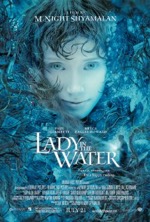
Starring: Paul Giamatti
July 2006
“Shyamalan’s Scary Tale Succeeds by Taking Risks”
The word “narf” effortlessly plopped out of director M. Night Shyamalan’s mouth one evening as he was telling his children a bedtime story. That homespun fairytale soon became the creative fodder for Shyamalan’s latest thrill-fest, Lady in the Water. From the start, Shyamalan made it clear that the movie—an unconventional love story filled with mythological creatures—would be a radical departure from his other films.
The opening narration, conveyed in a series of petroglyphs, provides the particulars of the movie’s myth: Once every eon, an ancient race of humans send an envoy from their water world to meet with their surface-dwelling brethren in an attempt to ignite a great awakening among humans. A water nymph (narf) must find the “vessel”—a person of unique vision—that will usher in the era of peace. Despite repeated attempts throughout history, every narf ambassador has failed in her peace-fostering mission because “man doesn’t listen very well.”
As the story opens, we’re introduced to Cleveland Heep (Paul Giamatti), a tortured soul who manages an apartment complex in Philly. Cleveland’s mundane existence as handyman, exterminator and peacekeeper brings him into contact with many of the building’s colorful tenants, including the Hispanic couple and their five daughters, the Asian college student and her controlling mother, the Indian writer (Shyamalan) and his nagging sister, the eccentric jock who only exercises the right side of his body, the African American father who excels at crossword puzzles and his insightful son, the quartet of freethinking beer buddies and the newest tenant, a haughty movie critic.
It takes a while for Shyamalan to establish all of his characters and their relationships to each other, but when Story the narf (Bryce Dallas Howard) surfaces in Cleveland’s pool, the plot kicks into high gear and a first-rate mystery begins to unfold. Story quickly identifies the “vessel,” but determining the supporting players—the guild, the guardian and the symbolist—proves more problematic. Cleveland and his tenants, now bound by a common purpose, must protect Story from an aggressive, wolf-like creature called a skrunt until the giant eagle swoops down and carries her to freedom.
It all sounds a bit hokey on paper, but Shyamalan does a masterful job of balancing character and plot with the fantastical. In an effort to mitigate the moments of stark terror (which are far fewer and less severe here than in his other movies), Shyamalan has employed more humor this time, which is just a natural byproduct of the multi-layered and multi-cultural characters that populate his story. One of the ongoing sources of amusement is the Asian mother’s reticence to share the narf’s origin tale with Cleveland. At one point, Cleveland must act like a child and have milk and cookies on the woman’s couch in order to receive a short lesson in narf mythology. The arrogant critic also provides unexpected comic relief; his jaded commentary on romance movies and his miscalculation of the danger he’s in at the movie’s climax is highly entertaining.
There’s no doubt that Shyamalan can select stars (like Willis and Gibson) for his projects, but here he’s handpicked an amazing cast, each of whom shines in his or her own way and serves a different function in the director’s visionary yarn. Howard’s fair complexion and ethereal visage lends itself perfectly to the otherworldly Story. The fact that Story doesn’t know a lot about what’s going on makes the movie that much more riveting and satisfying. Giamatti works magic in the title role; his stuttering everyman is extremely likable and accessible—there’s something in his timbre and delivery that reminds me of a younger Richard Dreyfuss. As a reluctant leader, carrying around a Santa-sized sack of guilt from his wife’s death, Cleveland finds a measure of heroism within himself when his paternal instinct kicks in and drives him to protect Story at all costs. Cleveland is captivating throughout and is an excellent character study.
Some, undoubtedly, will find Shyamalan’s avant-garde resolution unpalatable; but you can hardly fault him for breaking with the “big twist ending” motif that’s marked all of his other films. Here, he tries something different, and, for better or worse, I applaud his efforts. Though Lady in the Water is far inferior to The Sixth Sense, it’s the most human Shyamalan tale to date—by assembling an excellent ensemble of intriguing characters, the auteur has delivered one of the most unique and refreshing movies to come along in quite some time. So, whether or not you buy into narfs and skrunts, know that Lady in the Water has inaugurated a new film genre…high-art fairytale.
Rating: 3
The Pink Panther (PG-13)
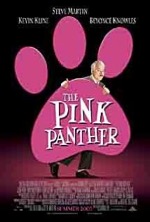
Starring: Steve Martin
February 2006
“Martin is Most Amusing When He Doesn’t Have a Clue”
Inspector Jacques Clouseau has been on quite a sabbatical. Last seen in 1993’s Son of the Pink Panther, it had been nearly twenty years before that when the brilliant Peter Sellers had finally hung up his detective’s hat after successfully playing the clumsy Clouseau in all four of the original Pink Panther movies.
This Pink Panther caper opens at a World Cup finals match between China and France in Paris. When the revered French coach is murdered by a poison dart at the conclusion of the contest and the famous Pink Panther diamond turns up missing, French police immediately launch an investigation. Chief Inspector Dreyfus (Kevin Klein) hatches a plan to catch the killer, an accomplishment that will solidify his claim on the elusive Medal of Honor—Dreyfus has been passed up for the coveted prize seven times. Dreyfus’ plan is to commission an incompetent cop to distract and divert the killer while he and the finest team of investigators in all of France nab the miscreant. The “perfect man” for the job is Jacque Clouseau (Steve Martin), a bumbling idiot and walking calamity, who mistakenly thinks his promotion to the rank of inspector is based on merit. What ensues is a witless investigation brimming with gags, double entendres and abject lunacy. Half the time I rolled my eyes, the rest of the time I was rolling on the floor at Martin’s unrelenting antics—he was the perfect choice to play dunderheaded Clouseau.
The movie’s storyline is essentially one catastrophe after the next. Some of my favorite moments are Clouseau’s alternate good cop/bad cop routine, Clouseau’s conversation with the Asian woman and the scene where Clouseau and his deputy sneak into Dreyfus’ ball in disguise. The movie’s creative highlight is when Clouseau crosses paths with 006—besides being uproariously funny, the scene features a nice bit of surprise casting.
And speaking of casting, the supporting characters add wonderful color and texture to the film, especially Ponton (Jean Reno), Clouseau’s vigilant deputy, Nicole (Emily Mortimer), Clouseau’s love interest, Xania the singer (Beyonce Knowles) and Yuri the trainer who trains (Henry Czerny). Martin and Klein are brilliant together, as are Martin and Reno; the scenes where Clouseau initiates random attacks on the deputy are idiotic and yet I still laughed. Perhaps that’s the film’s secret weapon; even when you don’t want to laugh, you end up doing it anyway…the movie is insidious that way.
Though The Pink Panther is replete with slapstick silliness, it’s also one hundred percent entertaining. Whether or not box office returns warrant a sequel, Martin’s Clouseau tickled me pink!
Rating: 2 1/2
Flightplan (PG-13)
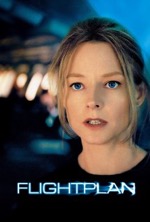
Starring: Jodie Foster
September 2005
“High-Flying Thriller Fulfills All of Its Plans”
Ever noticed how movies on a similar theme always end up being released in pairs? Hollywood catches wind of a hot-button topic or finds a bandwagon to jump on and at least two studios go head-to-head to be the first to capitalize on the subject. Invariably, one will gain supremacy (whether in quality, critical recognition or box-office success) over the other.
Clint Eastwood’s award-winning, paradigm-shifting western, Unforgiven (1992), prompted Buena Vista’s Tombstone (1993) and Warner Bros.’ Wyatt Earp (1994). Scientists predicting a catastrophic event from an asteroid collision informed Paramount’s Deep Impact (1998) and Buena Vista’s Armageddon (1998), while predictions of a manned-mission to Mars within the next thirty years gave us Buena Vista’s Mission to Mars (2000) and Warner Bros.’ Red Planet (2000).
So now Hollywood’s on an aviation kick, perhaps spurred on by last years’ The Aviator, with Dreamworks’ Red Eye and Touchstone’s Flightplan, two high altitude thrillers released a month apart. With Jodie Foster onboard, an airtight script by Peter A. Dowling and Billy Ray in the cargo hold and taut visioneering by director, Robert Schwentke, in the cockpit, this jumbo-jet really soars and is certainly the better of the two recent plane thrillers.
The movie opens with jet designer, Kyle Pratt (Foster), coaxing her six-year old daughter into boarding a new 474 double-decker jet headed from Berlin to N.Y.C. Also onboard, stored in the lower cargo section of the craft, is a casket containing Kyle’s recently-departed husband—he fell out of a window (uh, huh!).
Exhausted from recent events, Kyle dozes off… Three hours later, turbulence jolts Kyle from her respite and she discovers Julia is missing. At first, Kyle is merely worried when no one in her section remembers Julia boarding the plane—even the obnoxious kids sitting directly in front of them. After searching the entire plane, Kyle goes into panic mode and asks to see the captain. Captain Rich (Sean Bean) is at first sympathetic, ordering a full search of the plane, but when the stewardesses fail to turn up anything, the captain becomes cynical, even adversarial. Matters go from bad to worse when he learns that, according to the passenger manifest, there never was a Julia Pratt aboard. While the crew believes she’s hallucinating or suffering a mental breakdown from the loss of her husband, Kyle starts to wonder if she’s loosing her mind until she finds a piece of undeniable evidence that proves Julia is on the flight.
What begins as a run-of-the-mill “missing person” tale upgrades to a first-rate, edge-of-your-seat thriller, complete with terrorist activity, racial commentary and feral maternity. Foster is magnificent in her portrayal of a mother pushed to the edge—this is a brilliant, multi-layered character study, flawlessly conveyed and wholly believable. Like the gradual intensity of a sunrise or the steady temperature increase of a pot of water set to boil, Foster seamlessly morphs from concerned to alarmed, to panicked, to frenzied, to hysterical. These emotional gradients are masterfully executed by this veteran A-list actress, who is undoubtedly in her power-house prime.
The only noteworthy supporting players are Bean and Peter Sarsgaard, both of whom, ironically, have a fear of flying in real life. Bean’s Captain Rich stays just on the fringes of becoming a central character—his part is serviceable but certainly not noteworthy. Sarsgaard’s duplicitous air marshal is a more fleshed-out auxiliary player, but he falls just shy of being a memorable villain—Cillian Murphy’s antagonist in Red Eye was much more effective.
Besides some minor plot holes (i.e., why would hijackers kidnap the daughter of a woman who designed the plane?), Flightplan is a riveting thriller, made memorable by a solid script and Foster’s mesmerizing performance. Now, when can we book a flight on that new jet?
Rating: 3
The Interpreter (PG-13)
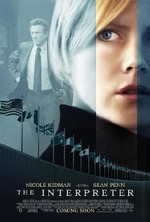
Starring: Nicole Kidman
April 2005
“A Highly Involved Thriller That’s Hard to Interpret”
The Interpreter should have been great. With two powerhouse actors in Sean Penn and Nicole Kidman, an A-list director in Sydney Pollack and a solid yarn spun from storywriters Martin Stellman and Brian Ward, and screenplay writers Charles Randolph, Scott Frank and Steven Zaillian, The Interpreter should have been the thriller of the year. Instead, it’s simply a good movie that features fine performances and a plot that is fairly relevant in our terror-wracked world.
Silvia Broome (Kidman), a skilled U.N. interpreter, returns to work late one night to retrieve a bag and overhears a whispered conversation detailing plans to assassinate a despised foreign leader, Zuwanie, in two days hence. Enter Tobin Keller (Penn), a member of the secret service, who is commissioned to investigate Silvia’s claim and verify her veracity or verisimilitude. At first, Silvia and Tobin’s conversations play out like a series of chess moves, but they gradually develop a tenuous friendship after opening up about their painful pasts. Some of the movie’s standout events are: a bus bombing, a man in a mask standing outside Silvia’s window on the fire-escape, and, of course, the climactic assassination attempt on the foreign terrorist’s life.
The Interpreter is engaging, if not a bit plodding at times, and spins elaborate webs of political intrigue, dark motives and sordid pasts. However, there’s so much going on in the movie, that the multitude of players and situations actually becomes a deterrent to the movie’s accessibility and enjoyment. What’s more, the end is patently predictable and there’s no real emotional payoff in the film.
Penn is solid, but he certainly isn’t stellar, and we’ve seen Kidman in meatier roles (The Hours), as well. The scene where Tobin tells Silvia that his wife died only twenty-three days earlier is the emotional core of the movie, but the meaningful interplay, like a New York minute, is over far too quickly and we’re back to muddy narrative and impotent action sequences. It’s a shame these two award-winning actors weren’t given the kind of material that would properly showcase their exceptional talents.
One gratifying aspect of the movie, however, is the extensive filming inside the U.N. building—this is the first movie to be accorded such a privilege (Hitchcock’s 1959 opus, North By Northwest, received no such dispensation, but the genius auteur grabbed a shot of Carey Grant climbing the steps of the U.N. building from across the street).
In the end, The Interpreter translates into an underachieving thriller that will soon blend in with all the other mediocre suspense films at Blockbuster.
Rating: 2 1/2
National Treasure (PG)
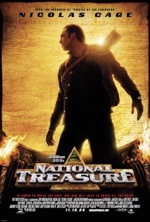
Starring: Nicholas Cage
November 2004
“One Man’s Treasure is Another Man’s Junk”
After getting past the preposterous notion that is the storyline of National Treasure, and after suspending my disbelief of the movie’s unfounded historical assertions and unrelenting contrivances, I actually found this Jerry Bruckheimer produced film to be modestly entertaining—in a “pass me the popcorn” sense. National Treasure surpassed my expectations and that’s largely due to the fact that the movie didn’t take itself too seriously, but rather, elevated the flimsy premise with fine performances and well-paced directing by Jon Turteltaub.
The first clue is discovered on an ice-entombed sailing ship in the Antarctic named “The Charlotte.” The rest of the clues involve Benjamin Franklin’s supposed secret writings and inventions and the Declaration of Independence (an invisible map inhabits the backside of the sacred document). What ensues is a present day Raiders of the Lost Ark romp, where the characters find and assemble clues in a multi-generational effort to discover a “spectacular” treasure that’s been collected and protected for centuries by the mysterious Freemasons—the earliest pieces span back to ancient Egypt.
Nicholas Cage (who plays lead character, Benjamin Franklin Gates) is a bit stiff at times, but his makeshift team, consisting of Abigail Chase (Diane Kruger) and Riley Poole (Justin Bartha), compensates for the actor’s deficiencies in compassion and comic relief. Cage cuts a confident figure as the adventurous treasure-seeker, but despite his best efforts to pull off the part of an action star, he still doesn’t hold a torch to Harrison Ford’s Indiana Jones (who could?).
Sean Bean, as Gates’ former partner turned chief adversary, Ian Howe, adequately portrays the “heavy,” but he was much better as the I.R.A. hit man in Patriot Games (another Ford connection). Playing Gates’ jaded father, Patrick, is Jon Voit, whose glorified cameo serves as the only voice of reason to his screen son’s wild leaps of logic and knee-jerk decisions. Brief appearances by Christopher Plummer and Harvey Keitel also pepper the movie; the former plays Gates’ grandfather and the later is the federal agent bent on capturing Gates and reacquiring the stolen Declaration of Independence.
National Treasure is action/adventure light: its like James Bond without any vices—no sex, no swearing and very little violence. The movie will doubtlessly seem insipid to hard-core action fans, but what the movie looses in S.W.M. viewers, it will undoubtedly more than recoup with younger viewers and whole families. Verdict: the movie’s appeal is extremely subjective—the audience will either discover a treasure trove or an empty chest.
Rating: 2 1/2
The Forgotten (PG-13)
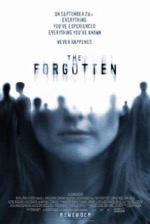
Starring: Julianne Moore
September 2004
“Solid Start, Forgettable Ending”
For three quarters of the movie, I was utterly gripped by the intriguing scenario and rampant paranoia that courses through this unconventional thriller. The film is made even more powerful by believable performances from Julianne Moore, Gary Sinise, Anthony Edwards and Alfre Woodard. Unfortunately, acting is the only element that is believable in the movie, as the story takes a significant left turn near the coda, destroying any momentum established in earlier acts.
Telly Paretta (Moore) lost her pre-teen son, Sam, in a plane crash and hasn’t been able to move past said traumatic event ever since that fateful day. Her memory of her son hasn’t faded one iota since his passing, but every item (picture, articles of clothing, etc.) of Sam’s has begun vanishing…one piece at a time. She accuses her husband (Edwards) and her shrink (Sinise) of conspiring to erase all traces of Sam’s former life. According to the two men, Telly never had a son, a revelation that becomes even more disturbing when she finds no records of the plane crash at her local library. Telly confronts her neighbor, a middle-aged drunk (Dominic West) and helps him remember his daughter that was also on the same plane. Together, Telly and her newfound friend seek to uncover this sinister plot that’s wiped away all physical evidence of their children’s existence. These events set up an interesting question in the viewer’s mind: is Telly crazy, or is some outside agency seeking to discredit and/or mentally destroy her?
Such an intriguing notion should have led to a riveting climax, but instead, the balloon deflates when an otherworldly twist is introduced into the plot. The children were abducted by aliens? This was all one big experiment to test the depths of the maternal instinct?? Even by its own rules, the “alien” subplot doesn’t hold up under scrutiny. How can aliens—with the ability to abduct a plane full of children, erase people’s memories, “beam” people up to the mother-ship and, indeed, even put events back to the way they were before the incident—be hampered by a time constraint on their test? If they can manipulate time, shouldn’t they be able to run the same test on the same person indefinitely? Time is relative, after all.
Therein lays the problem with The Forgotten. Tough hackneyed, a government conspiracy or scientific cover-up would have been a much more satisfying conclusion to such a solid foundation. Even though the special effects are few, they’re groundbreaking and breathtaking. Those scenes, combined with fine performances are the only things that keep the movie from becoming utterly forgettable.
Rating: 2 1/2
Sky Captain and the World of Tomorrow (PG-13)
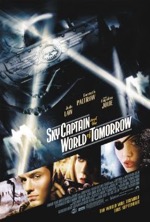
Starring: Gwyneth Paltrow
September 2004
“Long on Title, Short on Plot”
The “1/2” is for a solid cast, overall creativity and the groundbreaking manner in which the movie was filmed. The “two” is for an average tale that is further diluted by props, machines and plot devices that are so farcical and fantastical that they become a huge distraction—even to this reviewer, who can normally suspend his disbelief to the final frontier and beyond.
If Sky Captain and the World of Tomorrow could be distilled into one word it would be “derivative.” The movie borrows from many genre films and borders on plagiarism. Sky Captain (Jude Law) has a dash of Han Solo and a wardrobe similar to Indiana Jones’. And speaking of Indy, Raiders of the Lost Ark rip-offs abound, like the plane flying over the map trick or a fateful trip to the snow-capped mountains of Nepal. The attack on the hangar is suspiciously similar to the one seen in Pearl Harbor. Inside the hanger, as those with a steely eye will observe, is a T.I.E. fighter cockpit from Star Wars. The many plane/ship upgrades are an elaborate tip of the hat to the James Bond movies and the bizarre creatures on the tropical island look like they escaped from Jurassic Park. The robots themselves look like cousins of the Iron Giant and the mechanical, whirring noises they make are like something right out of the sound library from the original War of the Worlds. Also, Dex’s (Giovanni Ribisi) ray gun resembles a Buck Rogers sidearm.
Then there’s the plot. Dr. Totenkopf (canned footage of the late Sir Lawrence Olivier—one of the movie’s only masterstrokes) abducts all of the brilliant scientists previously involved in a top secret project and forces them to create giant robots and other such machines of mass destruction. Totenkopf’s ultimate goal is to create a second ark (rocket ship), which will ferry all of Earth’s animals (plus a few of his own creations) to a new planet, free from the evils of this present world. Trick is, all life on earth will be incinerated when the ship’s rockets burn up our atmosphere—proper judgment for the way we’ve mismanaged the planet. And it’s up to Sky Captain and his Swiss Army plane, along with his bickering partner, Polly Perkins (Gwyneth Paltrow) and his old flame, Franky Cook (Angelina Jolie) to save the day.
Hokey? You bet! And it’s a shame, because the movie features good characters with good dialogue, performed by good actors. The effects are nothing short of amazing and the visual style is moody and unique. If anything holds the movie back it’s the contrived storyline. In the final analysis, Sky Captain and the World of Tomorrow is a brilliant disappointment.
Rating: 2 1/2
The Village (PG-13)

Starring: Sigourney Weaver
July 2004
“It Takes a Village…To Scare You Senseless”
M. Night Shyamalan’s fourth chill-fest is both better and worse than his previous cinematic offerings (The Sixth Sense, Unbreakable and Signs). Shyamalan should be lauded for breaking with his usual formula and milieu, while maintaining strong character vignettes and intensely frightening situations. If possible, his directing here is even tighter than in the earlier trilogy and his clout has surrounded him with a stellar cast this time around—his first ensemble piece.
Joaquin Phoenix is back from Signs, and plays Lucius Hunt, a fearless and laconic young man who has a secret love affair with Ivy (Bryce Dallas Howard, Ron’s daughter). Ivy is the blind daughter of village elder, Edward Walker (William Hurt), a reserved man who speaks in nineteenth century English with interminable pauses in each line. Rounding out the cast is Lucius’ mother, played by Sigourney Weaver and the slow-witted Noah Percy (Adrien Brody), who is also secretly in love with Ivy.
The movie sets up a bit slowly, but strikes a crescendo near the midpoint. It isn’t until about three fourths of the way through that tensions mount and events escalate, paving the way for a nail-biting climax and the patented Shyamalan surprise ending.
With The Village, it’s clear that Shyamalan has moved into the upper echelon of Hollywood directors; his craft is well honed and he evoked excellent performances from his actors, especially Phoenix, Howard and Brody—the twisted ménage a trois. It’s a lot easier to create scary scenes at night, but the lion-share of the frightening scenes in The Village are filmed during the day—right out in the open. This is just another testament to Shyamalan’s directorial prowess (I’m gonna’ film it at day and I’m still gonna’ scare the @*!/ out of ya’).
But a nagging question hovers just this side of the dread-inducing forest, is The Village as good as its predecessors? The answer is no, but it’s still a quality thrill-o-rama. Problem: Shyamalan has painted himself into a corner now that everyone is anticipating a trick ending each outing. His big screen sleight of hand will become exponentially harder to pull off now that the audience has become wise to his styles and tactics (I figured out the twist ending halfway through the movie).
James Newton Howard’s score adds another dimension of creepiness to the movie, as well as some early American-flavored cues. The costumes and sets are exceptionally well crafted and lend the movie another degree of authenticity. So, what have we learned from The Village? Stay away from the bad color, avoid mentioning “those we don’t speak of” and hope for a better movie the next time Shyamalan directs.
Rating: 3
I, Robot (PG-13)

Starring: Will Smith
July 2004
“Near-future Thriller With More Than Artificial Intelligence”
I have to admit, I, Robot was a lot better than I thought it was going to be. The script was “suggested” by Isaac Asimov’s classic book of the same title, but bears little resemblance to the original, save for the three laws of robotics and how a conflict in logic makes robots go haywire.
The movie opens with the suicide—later determined to be a homicide—of Dr. Alfred Lanning (James Cromwell), and detective Del Spooner (Will Smith) is called in to investigate. Spooner, who detests robots, soon picks up the trail of the fugitive robot and, after an extensive chase scene, brings the artificial man to justice. What Spooner uncovers in his investigation, however, is just the tip of the proverbial iceberg and a much bigger, sinister plot threatens to unleash itself upon the futuristic version of Chicago, circa 2035. Dr. Susan Calvin (Bridget Moynahan) is the only one who believes Spooner’s paranoid theory (no robot has ever killed a human before) and, along with the assistance of good robot, Sonny, helps Spooner fight off hoards of renegade robots while attempting to destroy the faulty computer brain that has turned the new NS-5s into aggressive, killing machines.
Smith doesn’t swagger as much in I, Robot as in Independence Day or the Men in Black films. There’s a bit more depth to his character this time around and Smith brings a maturity of craft to bear upon the part as the android-loathing detective—a role both emotionally and physically demanding.
The special effects in I, Robot are top notch and the near-future technology is especially ingenious: like holographic caution tape, futuristic freeways and cars (some with perfectly circular tires) and, of course, the eerily human-looking robots. Though visually tantalizing, I, Robot is derivative of other sci-fi extravaganzas: the armies of robots harkens back to the armies of battle droids in Star Wars: Episode I, or the throngs of clone troops in Star Wars: Episode II. Also, V.I.K.I, the main computer in control of all NS-5s, invokes marshal law and starts taking over the city by force—“humans must be governed for their own good,” the cold, logical, positronic mind reasons. This is the prelude to a scenario not unlike the Skynet tragedy as featured in the Terminator trilogy.
Even though it’s less than original, I, Robot is a great action flick that keeps you on the edge of your seat with an unexpectedly good storyline and I-popping I-candy to go with your popcorn.
Rating: 2 1/2
Solaris (PG-13)
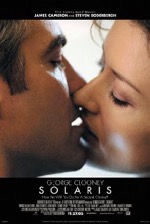
Starring: George Clooney
November 2002
It’s not often that I utterly despise a sci-fi movie, but here’s the exception. Dark, claustrophobic and static (not to mention, boring), the movie has no redeeming qualities. Solaris is pure, mind-numbing existentialism.
Rating: 1
Minority Report (PG-13)

Starring: Tom Cruise
June 2002
This is the first film in 2002 to deliver on all the hype and actually offer quite a bit more. An oft-dark vision of the future, Minority Report posits the notion that you can change the future; a powerful message even without the excellent plot and eye-popping effects.
Rating: 3
The Bourne Identity (PG-13)
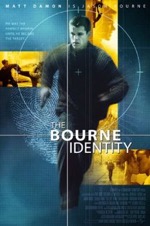
Starring: Matt Damon
June 2002
Intense from the word go, The Bourne Identity has great action (fight) sequences and plot to spare. Damon is surprisingly good in the lead role and the supporting cast is equally strong. Don’t look now, but Damon may have finally caught up to (if not surpassed) Affleck.
Rating: 3